Karl Shuker's Blog, page 12
March 29, 2021
CENTROPSAR AND SCLATER - THE CAUTIONARY TALE OF A NON-EXISTENT BIRD
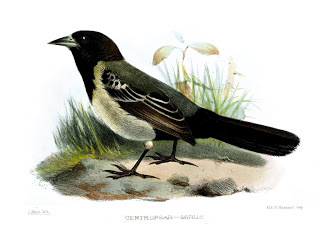 A hand-coloured lithograph from the Proceedings of the Zoological Society of London for 3 March 1874 by Joseph Smit, depicting the likely appearance in life of Centropsar mirus – if it had ever existed, that is… (public domain)
A hand-coloured lithograph from the Proceedings of the Zoological Society of London for 3 March 1874 by Joseph Smit, depicting the likely appearance in life of Centropsar mirus – if it had ever existed, that is… (public domain) During the Victorian era in Britain, Dr Philip Lutley Sclater FRS (1829-1913) was one of the great and the good within the zoological community, having described countless new species (especially birds), and serving for no fewer than 42 years (1860-1902) as Secretary of the pre-eminent Zoological Society of London (ZSL). Yet not even the great and the good are immune from error or misjudgment on occasion, and Sclater was no exception to this merciless rule – as a pretty little bird from Mexico would emphatically demonstrate in 1874.
That was the year when Sclater officially described and named a new species (and genus) of very distinctive passerine (perching bird) on pp. 175-176 in the 3 March issue of the ZSL's Proceedings. He dubbed it Centropsar mirus, and, as was the custom back in those days, listed its diagnostic morphological characteristics in Latin. His account was accompanied by a b/w sketch of the bird's head, wing, and foot (see below), plus the beautiful full-colour plate that opens this present ShukerNature blog article, which had been produced by renowned Dutch zoological artist Joseph Smit and depicted the likely appearance in life of this eye-catching avian novelty.
 The b/w sketch of the head, wing, and foot of C. mirus that was included within Sclater's formal scientific description and naming of this ostensibly new species (public domain)
The b/w sketch of the head, wing, and foot of C. mirus that was included within Sclater's formal scientific description and naming of this ostensibly new species (public domain)
It had been brought to Sclater's attention by much-travelled English ornithologist and zoological specimen collector Edward Bartlett, who had obtained a large collection of bird skins whose species had variously originated from western Mexico and Australia. Based upon the structure of its beak (slender, elongated, tapering to a point) and the specific nature of its short, rounded wings' remiges or flight feathers (the third, fourth, and fifth of its primaries being the longest), Sclater readily recognized that the skin designated by him as the type (and only known) specimen of C. mirus was from an icterid.
Icterids constitute a morphologically diverse taxonomic family of birds wholly endemic to the New World, and include such familiar American species as the bobolink, meadowlarks, red-winged and yellow-headed blackbirds, grackles, cowbirds, Baltimore and other orioles, troupial, and oropendolas (despite their common names, these meadowlarks, blackbirds, and orioles are unrelated to their respective Old World namesakes). Consequently, this meant that the C. mirus specimen must have originated in western Mexico, because there are no icterids of any kind in Australia.
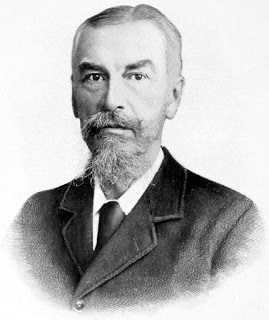 Dr Philip Lutley Sclater (public domain)
Dr Philip Lutley Sclater (public domain)
Yet although this intriguing bird appeared to be an icterid, when its above-described icterid features were added to its small, weak, slender feet, straight elongated hind claw on each foot, and stiffened retrices (tail feathers) with attrite tips, these characteristics collectively differentiated it from all known icterid genera. This is why Sclater created a brand-new one in order to accommodate it. It is also why he chose mirus – 'wonder' – as its species name, to signify how surprised he had been by this bemusing little bird's unheralded combination of features. So far, so good – until, that is, the newly-described Centropsar mirus came by virtue of Sclater's PZSL account to the attention of a certain Dr Jean Cabanis (1816-1906), who was arguably Germany's foremost ornithological expert at that time.
In 1853, Cabanis had personally founded one of the scientific world's most prestigious periodicals devoted to birds, the Journal für Ornithologie, which he also edited for the next 41 years. Consequently, in 1874, published within Vol. 22, pp. 457-458, of his journal as a succinct but very revealing response to Sclater's earlier pronouncement in the PZSL, Cabanis presented his own opinion regarding Centropsar. Although couched in studiously polite terms, his cloaked comments made uncomfortable reading, especially for Sclater.
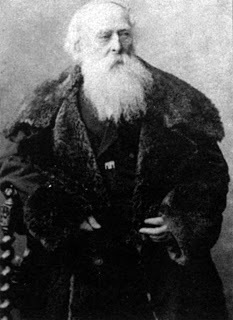 Dr Jean Cabanis (public domain)
Dr Jean Cabanis (public domain)
Translating from the German, Cabanis's non-technical remarks were a triumph of silky suspicion:
Dr. Sclater has chosen the species name mirusvery aptly; that the bird which arouses the most lively interest is in fact "wonderful" and difficult to reconcile with our concepts of "natural" systematics. If it were not brought to science by such an eminently experienced ornithologist as Dr Sclater, one would be entitled to regard it as an artefact. From the description and the illustrations, however, no final judgment could be made, since an error could possibly also have been made.
Ouch!
Cabanis then considered the technical minutiae of its morphology, which evidently and understandably perplexed him, because Centropsar uniquely embodied characteristics drawn from two entirely separate taxonomic groups of bird. Clearly something was drastically amiss here, and Cabanis knew it. Yet as he had not examined this bird personally, he felt unable to say more, but his doubts had been clearly expressed for all to see. He ended his comments with a final, singularly prophetic one: "Surely the wonderful Centropsar will get its natural solution".
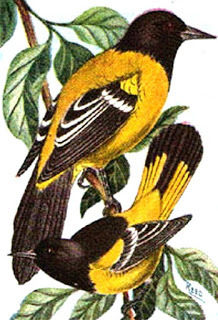 A pair of adult Audubon's orioles – belonging to the New World icterid family, and therefore unrelated to the Old World orioles (public domain)
A pair of adult Audubon's orioles – belonging to the New World icterid family, and therefore unrelated to the Old World orioles (public domain)
It will come as no surprise to learn that once Sclater had read Cabanis's ill-concealed challenge to his identification of the unique, taxonomically impossible Centropsarspecimen, he lost no time in re-examining it, but now in much closer detail, only to uncover the awful if inevitable truth. To his credit, however, Sclater put on a brave face and confessed all at a meeting of the Zoological Society of London shortly afterwards, with his mea culpa duly documented in the 1 June 1874 issue of the PZSL:
Mr. Sclater laid on the table the typical [i.e. type] specimen of his Centropsar mirus (P.Z.S. 1874, p. 176, pl. xxvi.), and made the following remarks:-
"My suspicions having been awakened as to this specimen by information received from Mr. E. Bartlett and by the criticisms of Dr. Cabanis ('Journ. für Orn.' vol. xxii, 1874, p. 458 [although Cabanis's comments actually began on p. 457]), I have made a thorough reexamination of it.
"The result arrived at is that the supposed novelty is undoubtedly composed of parts of three other birds. The head, wings, and body are those of a female or immature Icterus, possibly I. auduboni [Audubon's oriole, nowadays reclassified as a subspecies of the black-headed oriole I. graduacauda], though I have no specimen quite agreeing with it. To this have been added the worn tail of an Agelaeus gubernator [nowadays reclassified as Agelaius phoeniceus gubernator] or A. phoeniceus [the red-winged blackbird], and the legs of an Otocorys [nowadays renamed Eremophila, consisting of two species of Old World horned lark].
"Centropsar mirus may therefore be removed from the ornithological category. Mr. E. Bartlett tells me that there were other fictitious specimens in the same collection."
"Now he tells me!" may well have been the unspoken thought running through Sclater's mind when he uttered that last confessional comment at the ZSL meeting!
 A red-winged blackbird, belonging to the New World icterid family, and therefore unrelated to the Old World blackbirds (public domain)
A red-winged blackbird, belonging to the New World icterid family, and therefore unrelated to the Old World blackbirds (public domain)
So, the wonderful Centropsar had been unmasked not as a wonder at all, but merely as a heterogeneous humbug. It was a feathered Frankensteinian creation subtly stitched together with body parts from two different species of New World icterid plus an alaudid or true lark, i.e. collectively representing two entirely separate taxonomic families!
Yet to be fair, this composite skin must have been prepared with no small amount of skill in order for it to have fooled, at least on first sight, even as immensely experienced an ornithologist as Sclater, so we shouldn't be too hard upon him. He wasn't the first to have been tricked by a fine-feathered fraud, and he certainly won't be the last!
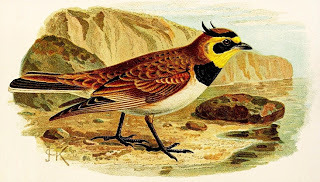 Painted in 1891 by another acclaimed Dutch bird artist John G. Keulemans, and native to much of the northern hemisphere, this is a horned (shore) lark – a species of alaudid or true lark, and therefore unrelated to the icterids (public domain)
Painted in 1891 by another acclaimed Dutch bird artist John G. Keulemans, and native to much of the northern hemisphere, this is a horned (shore) lark – a species of alaudid or true lark, and therefore unrelated to the icterids (public domain)
March 27, 2021
RAT KINGS – A TANGLED TALE OF TANGLED TAILS
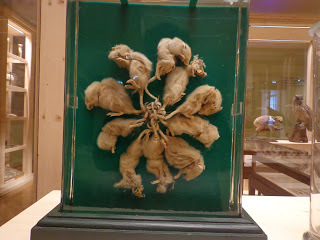 The Dellfeld rat king, on display at the Musée zoologique de la ville de Strasbourg, France (© Edelseider/Wikipedia –
CC BY-SA 4.0 licence
)
The Dellfeld rat king, on display at the Musée zoologique de la ville de Strasbourg, France (© Edelseider/Wikipedia –
CC BY-SA 4.0 licence
)
Among the most unusual but prized museum specimens are preserved aggregations of black rats Rattus rattus inextricably linked to one another by their tails - which are so thoroughly entangled that the rats have been unable to disentangle themselves and escape. A grotesque, tail-entwined aggregation of this type is termed a rat king or 'roi de rats'. This is possibly a corruption of the French 'rouet de rats' - 'rat wheel' – as the tails when straightened out radiate outwards from the central uniting knot like the spokes of a wheel radiating out from the wheel's central hub. Yet despite centuries of reports and occasional captures, the mystery of how their tails become so intertwined remains unsolved.
MORE THAN FOUR CENTURIES OF RAT KINGS
The earliest currently-documented record of a rat king dates from 1564, more than four centuries ago. It takes the form of a woodcut illustrating a poem in the monumental emblem book authored by renowned Hungarian scholar-historian Johannes Sambucus, entitled Emblemata cum aliquot nummis antiqui operis, Ioannis Sambuci Tirnaviensis Pannonii. The poem tells of a rodent-plagued man whose servant discovers seven rats with their tails inextricably tangled together, and this rat king (though not referred to by that term in the poem) is depicted as alive and in some detail within the engraving. The accuracy of the depiction shows that rat kings were known as far back as the 1500s, and suggests that it was based upon a specific example, though no written documentation of this example apparently exists.
 The 1564 woodcut illustrating a living rat king composed of 7 specimens (public domain)
The 1564 woodcut illustrating a living rat king composed of 7 specimens (public domain)
Since then, more than 60 specimens have been recorded, spanning the time period 1612-2005, though at least 18 of them are of dubious authenticity (some rat kings have been fraudulently created as unusual - and expensive! - souvenirs for the unwary traveller or curio collector). Furthermore, despite being associated with superstitions that their discovery is a portent of the plague and other evils, several rat kings are greatly-prized exhibits in various museums.
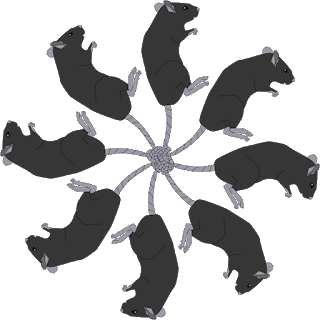 Rat king, diagrammatic representation (© Di (they-them)/Wikipedia –
CC BY 4.0 licence
)
Rat king, diagrammatic representation (© Di (they-them)/Wikipedia –
CC BY 4.0 licence
)
Intriguingly, most reported rat kings are of German origin, though why this should be is unclear (unless German writers took greater pains to chronicle any such anomalous finds in their own country than writers of other nationalities have done regarding rat kings found in theirs?). The single most comprehensive source of rat king information is Martin Hart's book Rats, which devotes an entire and very extensive chapter to the subject (once again, moreover, Hart is German, and his book was originally published in German, with an English translation appearing in 1982).
 Rat king, early 1700s engraving (public domain)
Rat king, early 1700s engraving (public domain)
Space considerations obviously prevent me from covering within this present ShukerNature blog article every single rat king on record, but a representative selection, including the most dramatic and unusual cases, appear in the following review.
A RAT KING REVIEW
The first on the total list of specimens on record is a nine-rat example that was discovered on 20 March 1612 behind a partition in a loft in Danzig (now Gdansk), Poland, by a local professor. All of the rats were adult, appeared well-fed, and were alive when found. Its details were included in a letter from the professor to a colleague in Basle, Switzerland. This was followed 71 years later by the finding of a six-rat king in Strasbourg on 4 July 1683; these rats were all juveniles.
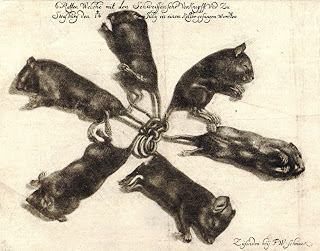 Strasbourg rat king from 1683 (public domain)
Strasbourg rat king from 1683 (public domain)
A very remarkable example was the 18-rat king discovered on 12 or 13 July 1748 by miller Johann Heinrich Jäger at Grossballhausen (also spelt 'Gross Ballheiser') in Germany, when it fell from between two stones underneath his mill's cogwheels. Strangely, a famous, beautifully-executed copper engraving of this very noteworthy rat king depicts it with only nine rats present (unless, perhaps, the other nine are hidden beneath the nine portrayed?).
 Copper engraving depicting a 9-rat version of the 18-rat Gross Ballheiser rat king from July 1748 (public domain)
Copper engraving depicting a 9-rat version of the 18-rat Gross Ballheiser rat king from July 1748 (public domain)
Also controversial in terms of its visual portrayal is the rat king discovered in Erfurt, Germany, in 1772. For whereas in his book Hart lists it as a 12-rat king, a detailed engraving of this example dating back to the early 1800s portrays it as containing only ten rats - but also with a very stylised, unnatural-looking knot. Consequently, this picture may have been intended merely as a general rat king representation, rather than as a specific depiction of the Erfurt example.
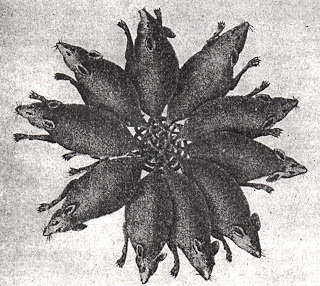 Illustration depicting a 10-rat version of the 12-rat Erfurt rat king from 1772 (public domain)
Illustration depicting a 10-rat version of the 12-rat Erfurt rat king from 1772 (public domain)
On 11/12 January 1774, an amazing 16-rat king was found in a windmill at Lindenau, Germany, with all of its rats still alive. After they had been killed, the king was subsequently displayed in Leipzig, and it proved to be a very popular attraction.
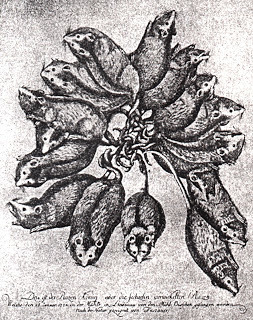 Illustration of the Lindenau rat king from January 1774 (public domain)
Illustration of the Lindenau rat king from January 1774 (public domain)
Even more extraordinary was the discovery made during December 1822 at the village of Döllstadt in eastern Germany, when some threshers on a farm found two separate rat kings within a hollow beam in a barn roof attic. In both of these kings, the rats were all adult, alive, and apparently healthy. One of the kings consisted of 28 rats, the other consisted of 14 rats. The threshers killed all of them with their threshing flails and then, after great difficulty, the rats in each king were separated. Of particular interest, as originally noted by a forester who witnessed the rats' separation, is that the tail of each freed rat clearly bore the impression of the tails of the other rats in its king, thus demonstrating how tightly their tails had been entwined.
 The veritable rat emperor discovered at Buchheim, Germany, in May 1828, now preserved in the Mauritanium at Altenburg, Germany (© Altenburg Mauritanium/Wikipedia –
CC BY-SA 3.0 licence
)
The veritable rat emperor discovered at Buchheim, Germany, in May 1828, now preserved in the Mauritanium at Altenburg, Germany (© Altenburg Mauritanium/Wikipedia –
CC BY-SA 3.0 licence
)
The most spectacular, monstrous rat king on record, however, was discovered inside the chimney of a miller named Steinbruck at Buchheim, Germany, in May 1828. Incredibly, it contained no less than 32 rats, although they were probably not adults, which were hairless, desiccated, and inescapably bound to one another by their Gordian-knotted tails. This exceptional rat king - indeed, a veritable rat emperor! - is today a much-valued specimen in the Mauritianum, a natural history museum in Altenburg, Germany.
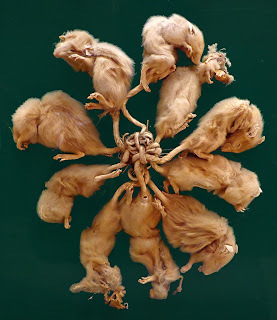 Close-up of the rat king found in 1894 (1895 in some accounts) at Dellfeld, Germany, housed in Musée zoologique de la ville de Strasbourg, France (© Edelseider/Wikipedia –
CC BY-SA 4.0 licence
)
Close-up of the rat king found in 1894 (1895 in some accounts) at Dellfeld, Germany, housed in Musée zoologique de la ville de Strasbourg, France (© Edelseider/Wikipedia –
CC BY-SA 4.0 licence
)
Another preserved rat king can be found in Strasbourg Museum. This is a ten-rat example, whose rats were all juveniles and discovered in a frozen condition under a bale of hay during April 1894 in Dellfeld, Germany. Three of the rats had bite marks, indicating that they may have been bitten by others in the king, or had been attacked in their defenceless state by free rats.
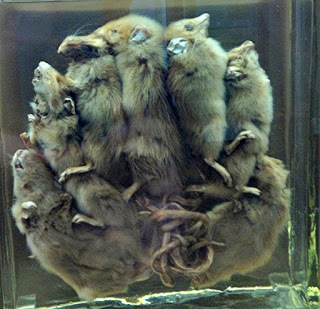 Rat king from Ruderhausen, found in 1907 (© Markoz/Wikipedia – copyrighted free use)
Rat king from Ruderhausen, found in 1907 (© Markoz/Wikipedia – copyrighted free use)
Yet another, more recent preserved example is the rat king discovered in 1907 at Ruderhausen, near Germany's Harz Mountains. It resides today in the collections of Göttingen's Zoological Institute. Indeed, this institute may once have possessed a second rat king too, obtained in the very same year, because a number of sources of rat king information list a specimen formerly held at this establishment that was reputedly found in January 1907 at the village of Capelle, near Hamm, Westphalia, in Germany, and brought to scientific attention by the local pastor, called Wigger. If these sources are correct, however, it must have since been lost, as no such specimen exists today.
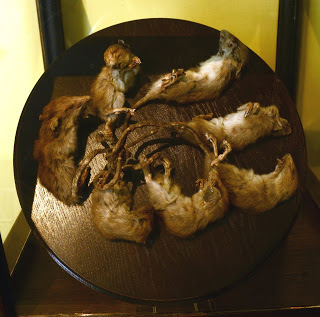 Rat king from Limburg, Netherlands, found in unknown circumstances during 1955, now housed at the Natural History Museum of Maastricht, Netherlands (Vassil - public domain)
Rat king from Limburg, Netherlands, found in unknown circumstances during 1955, now housed at the Natural History Museum of Maastricht, Netherlands (Vassil - public domain)
A rat king consisting of eight juveniles has been on public display for several decades in a jar of preserving fluid at New Zealand's Otago Museum. Sometime during the 1930s, it fell down onto the ground, alive, from the rafters of the company shed of Keith Ramsey Ltd on Birch Street, Otago – followed swiftly by a parent rat that defended them vigorously. The rats' tails were bound together not only by one another but also by horse hair, which is used as nesting material by rats.
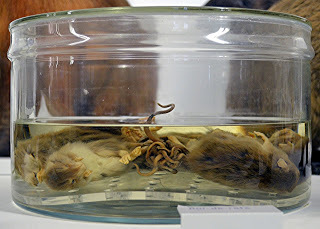 Rat king found at Vendée, France, in 1986, now preserved at the Muséum d'Histoire Naturelle de Nantes, France (© Selbymay/Wikipedia –
CC BY-SA 3.0 licence
)
Rat king found at Vendée, France, in 1986, now preserved at the Muséum d'Histoire Naturelle de Nantes, France (© Selbymay/Wikipedia –
CC BY-SA 3.0 licence
)
In February 1963, a seven-rat king was found by farmer P. van Nijnatten partly concealed under a pile of bean sticks in his barn at Rucphen, in North Brabant, Holland. In the hope of uncovering its secret, after its rats (all adults) had been killed this king was x-rayed, revealing some tail fractures and signs of a callus formation - all indicating that the knot of tails had occurred quite some time ago.
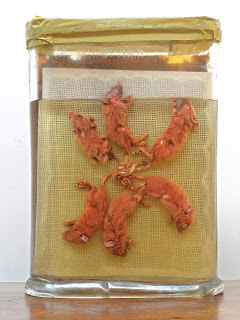 Rat king from Châteaudun, France, found in November 1889; now housed at Châteaudun Museum (© Selbymay-Wikipedia –
CC BY-SA 3.0 licence
)
Rat king from Châteaudun, France, found in November 1889; now housed at Châteaudun Museum (© Selbymay-Wikipedia –
CC BY-SA 3.0 licence
)
More recent still is the rat king found by some gamebird rearers on 10 April 1986 in the municipality of Mache near Aizenay Vendée, France, and now preserved in alcohol at the natural history museum at Nantes. This king was originally composed of 12 rats, but three subsequently became detached, and it is the resulting 9-rat version that is preserved. The only other preserved French rat king is one that was discovered in November 1889 at Châteaudun and duly presented to its museum where it is still retained today; photographs of it show that it contains six rats, but I have read reports testifying that there were seven originally.
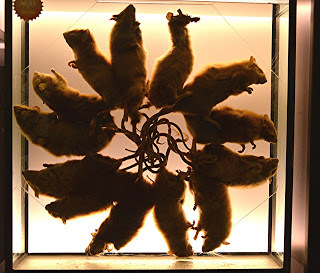 Rat king from Saru, Estonia, found in 2005, now housed at the University of Tartu's Natural History Museum (© Ivo Kruusamägi/Wikipedia –
CC BY-SA 4.0 licence
)
Rat king from Saru, Estonia, found in 2005, now housed at the University of Tartu's Natural History Museum (© Ivo Kruusamägi/Wikipedia –
CC BY-SA 4.0 licence
)
Most recent of all, however, is an Estonian rat king, consisting of 16 rats, nine or so of which were still alive when the king was discovered alive by farmer Rein Kõiv on 16 January 2005, squeaking loudly upon the sandy floor of his shed in the village of Saru. Kõiv killed them all, and on 10 March 2005 the king was taken to the Natural History (Zoological) Museum at the University of Tartu, where it was preserved in alcohol and is now on display. Prior to this, however, two of the rats had been eaten by a predator and a third had been thrown away by Kõiv himself. Two other Estonian rat kings have been reported, both during the 20th Century, but neither of them was preserved.
A KNOTTY PROBLEM
A number of explanations for the formation of rat kings have been offered. One of the most popular is that if rats huddle together for warmth in damp or freezing surroundings, with their tails pressed against one another, their tails become sticky and soon adhere to or become frozen against one another, becoming ever more entangled and fixed as the rats thereafter strive to pull free. However, if this were indeed the correct explanation, being such a frequent, commonplace scenario it would surely engender far more examples of rat kings than have been documented so far?
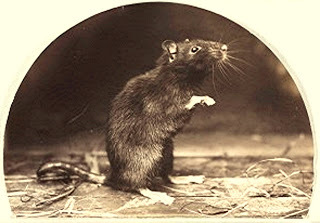 Vintage sepia photograph of a black rat (public domain)
Vintage sepia photograph of a black rat (public domain)
Another notion is that a rat king is actually a single litter whose members' tails became entangled while the rats were still in their mother's uterus. If this were true, however, it seems highly unlikely that they would survive to adulthood, as they would be unable to obtain much food, yoked together in this manner. Yet most rat kings on record feature adult specimens, and ones that are often healthy when found.
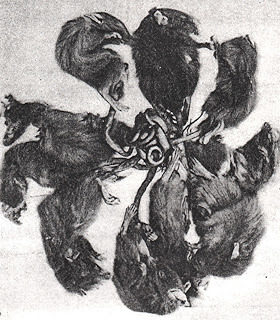 A 10-specimen rat king at the Strasbourg Museum (public domain)
A 10-specimen rat king at the Strasbourg Museum (public domain)
Equally intriguing is why all but three of these murine kings feature black rats Rattus rattus. There is none involving the much more common brown rat R. norvegicus, but this may be due to the fact that the brown rat's tail is shorter, thicker, and less flexible than that of the black rat. Indeed, the only rat exception to the black rat rule is an Indonesian king consisting of ten young Asian field rats R. brevicaudatus, discovered on 23 March 1918 in Buitenzorg (aka Bogor), Java. In addition, a single king composed of house mice Mus musculus has been recorded (documented in a Russian book dealing with mice and rats). So too has one field mouse king, consisting of several juvenile long-tailed field mice Apodemus sylvaticus, found at Holstein, Germany, in April 1929.
SQUIRREL KINGS
However, not all rodent kings involve rats or mice. At least 17 naturally-occurring squirrel kings have also been recorded (certain cruel, vile cases of squirrels having been forcibly tied together via their tails by human sadists are also known, tragically). Yet the concept of bushy-tailed squirrels becoming entwined together in this way seems even more incongruous than that of rats.
A seven-squirrel king was discovered in a South Carolina zoo on 31 December 1951. Tragically, however, two of its members were dead, a third was dying, and its four other members could only be separated by cutting off their tails above the knot. Curiously, two other squirrel kings have been found here over the years, and all during cold snowy weather, implying that the squirrels had huddled together for warmth.
Video of the successful rescue and separation of five juvenile squirrels constituting a living squirrel king, their tails having become stuck together via tree sap (© Guillaume Dutilh/YouTube)
A king containing six young squirrels was spotted by schoolgirl Crystal Cresseveur in a hedge outside her home in Easton, Pennsylvania, on 24 September 1989. Although they were eventually rescued, their tails could not be disentangled. A five-squirrel king (two members of which were albinos) fell out of a tree by Reisterstown Elementary School in Baltimore, Maryland, on 18 September 1991, but these were successfully separated as their tails were linked to one another only indirectly, with sticky tree sap, tangled hair, and nest debris. In Europe, at least two kings of red squirrels Sciurus vulgarishave been recorded - one in August 1921, the other on 20 October 1951 (which was later preserved).
In July 1997, what looked at first like a huge hairy spider was spotted under a tree in Brantford, in Ontario, Canada, but a closer look revealed that it was actually a squirrel king, composed of five young squirrels whose tails were braided together right up to their bases. They were taken to a vet, Cathy Séguin, who freed them, but she feared that the loss of circulation that their tails had suffered would result in part of each tail dying.
CAT KINGS
Analogous to rat kings, mouse kings, and squirrel kings is the even more obscure phenomenon of cat kings. Here, however, it is the umbilical cords of kittens in newborn litters that are tangled and intertwined, not their tails. Such curiosities are extremely rare, but at least a dozen have been documented in the scientific literature.
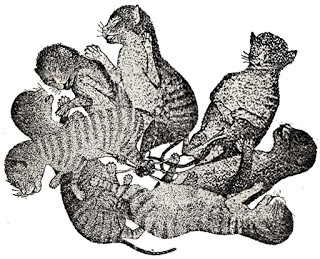 The Rennes cat king from 1937 (public domain)
The Rennes cat king from 1937 (public domain)
Perhaps the best known is the cat king recorded in October 1937 at Rennes, in Brittany, northwestern France. It consisted of a litter of eight small kittens, seven of which (males and females) were held closely together via their entangled umbilical cords. Indeed, the entanglement was so complex that even the left hind legs of two of the kittens had become bound up to one another. The kittens in this cat king were discovered dead, but it is not known whether their cords' complicated intertwining had occurred before the litter's birth or afterwards.
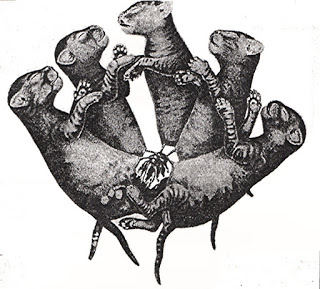 Engraving of the cat king reported in 1841 (public domain)
Engraving of the cat king reported in 1841 (public domain)
A cat king recorded in 1841 consisted of five unborn kittens whose entwined umbilical cords were still fixed to their mother's placenta. This shows that such entanglement can indeed occur while the kittens are still in the womb. The earliest cat king known to me is a five-kitten specimen from 1683, found in Strasbourg, France.
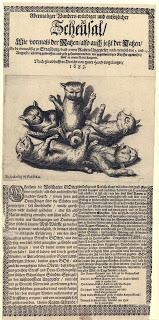 Report of the Strasbourg cat king from 1683 - click to enlarge for reading purposes (public domain)
Report of the Strasbourg cat king from 1683 - click to enlarge for reading purposes (public domain)
Today, the mystery of how rat kings are formed remains exactly that – an unresolved anomaly whose reality has spanned centuries but whose secret still awaits disclosure. Some sceptics have cynically suggested that the phenomenon is simply a hoax, that the knotting together of the tails of rats in a king is clearly the result of deliberate human activity. Bearing in mind, however, that most of the rat kings on record were discovered when their rats were very much alive and often still in good health (albeit hungry and frightened), and that the tail knots were exceedingly complex, all that I can say in response to these sceptics is that they have certainly never attempted to tie the tails together of several (not to mention 18 or 32!) live, healthy rats. If they were ever brave (or foolish) enough to try to do so, their cynicism would very swiftly vanish – along, quite possibly, with several of their fingers!
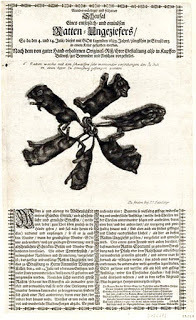 Report of the Strasbourg rat king from 1683 - click to enlarge for reading purposes (public domain)
Report of the Strasbourg rat king from 1683 - click to enlarge for reading purposes (public domain)
This ShukerNature blog article is excerpted from my book A Manifestation of Monsters.
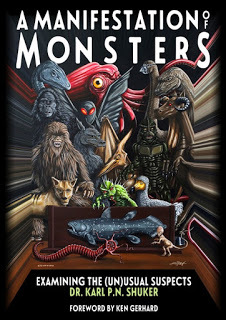
March 23, 2021
IS THIS MYSTERIOUS PAINTING A PORTRAIT OF THE NUNDA?
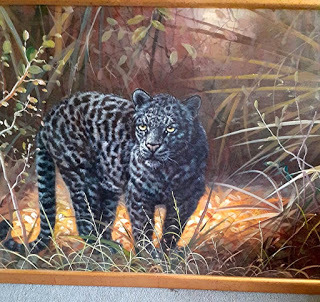 Close-up of an extremely distinctive big cat that looks very like native descriptions of a Tanzanian mystery felid known as the nunda or mngwa, as depicted in a mysterious painting recently encountered and purchased by longstanding Facebook friend Maxine Pearson (© Maxine Pearson)
Close-up of an extremely distinctive big cat that looks very like native descriptions of a Tanzanian mystery felid known as the nunda or mngwa, as depicted in a mysterious painting recently encountered and purchased by longstanding Facebook friend Maxine Pearson (© Maxine Pearson) In a previous ShukerNature blog article (click hereto access it), I documented one of the most ferocious mystery beasts ever recorded – an East African mystery big cat (morphologically but not necessarily taxonomically) that was reported from coastal Tanzania during the first half of the 20th Century, and known variously as the nunda or mngwa. It was blamed for the bloodthirsty slaughter of several locals during two separate outbreaks of killings, but was never captured. A few fur samples were obtained, but tragically they were not retained for formal scientific examination. According to eyewitness descriptions, however, this rapacious cryptid was described as being a cat the size of a donkey, and leaving behind leopard-like footprints the size of a lion's, but readily delineated from both leopards and lions by virtue of its most unusual pelage. This was said to be grey in colour and brindled in pattern, i.e. marked with streaks and possibly some spotting too, as brindled animals often exhibit spots among the streaks and stripes.
No known species of cat fits this description in toto. The nearest is the grey, sometimes spotted morph of the African golden cat Caracal (=Profelis) aurata, but at only twice the size of a typical domestic cat, this species is far smaller than the nunda, and surely therefore could not inflict the terrible wounds or attack humans with such overwhelming ferocity as described for the nunda. However, veteran cryptozoologist Dr Bernard Heuvelmans speculated that perhaps the nunda constituted a hitherto-undiscovered giant version of this species, which would be a truly belligerent beast to encounter.
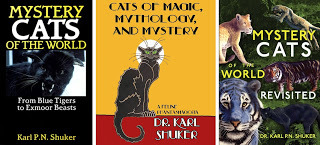 My three books on mystery cats (
© Dr Karl Shuker)
My three books on mystery cats (
© Dr Karl Shuker)
Tellingly, moreover, as I pointed out in my mystery cat books, locals have claimed that despite its huge size, the nunda does not roar like a Panthera big cat (lion, tiger, leopard, jaguar), but actually purrs, like what are collectively known taxonomically as the small cats, and which include the African golden cat among their number. In addition, the African golden cat is so notoriously elusive that it has actually been dubbed by mammalogists as Africa's least known felid (click herefor more details), so of all cats native to this continent, it may well possess the greatest potential for unveiling unexpected, unsuspected attributes.
Over the years, a number of artists have sought to depict Tanzania's monstrous mystery cat, of which the following example is probably the best known:
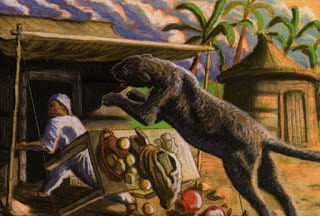 Cryptozoological artist William Rebsamen's vivid representation of an attacking nunda (© William M. Rebsamen)
Cryptozoological artist William Rebsamen's vivid representation of an attacking nunda (© William M. Rebsamen)
Very recently, moreover, what may be a hitherto-undocumented and truly spectacular painting of a nunda was discovered in the most unexpected of circumstances. Now, by kind permission of its discoverer (and purchaser), longstanding Facebook friend Maxine Pearson, here for your cryptozoological consideration via this ShukerNature world-exclusive is that truly remarkable and extremely beautiful painting, together with the sparse details currently available regarding it. Consequently, Maxine and I very much hope, kind readers, that you will be able to assist us in uncovering further information relating to it.
I first learned of this painting's existence on Sunday 21 March 2021, when I received a short message on Facebook from Maxine, enclosing the close-up of the cat in the painting that opens this present ShukerNature article, plus a close-up of the artist's signature, and the following information:
Jon Downes [of the Centre for Fortean Zoology, based in Devon, UK] said he thinks this may be a mngwa. I just got it from some charity auction. It's in oils. The painter's name [is] below although I don't know him. Any thoughts?
When I looked at the close-up photograph of the cat, I was certainly very intrigued, and could readily see why Jon thought that it might be a mngwa (aka nunda – I prefer the latter name, as it's easier to say!), and I replied to Maxine stating this. I asked if she could provide me with any additional details regarding the painting and any further photographs of it, which she very kindly did. I'm incorporating the most significant of those photos (which she snapped using her Samsung mobile phone) throughout this article, and here are the additional details:
Maxine lives in London, but the auction at which she won this painting was held next to the garrison at Eastbeach, Shoeburyness, in southeast Essex, England, by a Southend-based animal charity named Charlie Boys Angels (see details concerning it given at the end of this ShukerNature article), of which she is a member. Charlie Boys Angels helps homeless people with dogs, and as one of its means of raising funds for this very deserving cause it holds an auction every month. After winning the painting with a bid for £15, Maxine received it from Charlie Boys Angels about a week ago, and was quite surprised to discover how large it was, measuring approximately 4 ft across by just under 3 ft tall. The identity of the person who donated this painting to the auction is currently unknown, but Maxine has promised to ask the charity if they know, so I may be able to add this detail here at a later date.
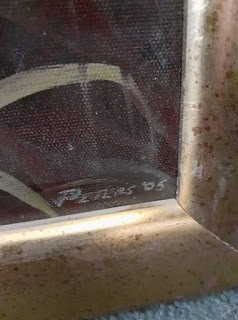 Close-up of the artist's signature, visible at the bottom right-hand corner of the painting - click photo to enlarge it for viewing purposes (© Maxine Pearson)
Close-up of the artist's signature, visible at the bottom right-hand corner of the painting - click photo to enlarge it for viewing purposes (© Maxine Pearson)
Also currently unknown is the identity of the artist who painted it. As seen in the above close-up photograph of the artist's signature, his/her surname may be 'Peters', and the "'05" inscription next to it indicates that it was painted in 2005. However, Maxine is not totally certain that Peters is indeed what the signature reads as, and even if it is, Peters is a very common name, meaning that without additional information it would be exceedingly difficult to track the artist down. I have tried both a Google Image search and a Tineye Reverse Image search in the hope of discovering this painting online, but without success.
Interestingly, as seen here, when the painting is photographed in its entirety the colouration of the cat varies depending upon the painting's location. When Maxine photographed it by a window, the light from the window shining upon it rendered the cat very dark, so that it almost resembled a black panther (i.e. melanistic leopard), with its markings not particularly distinct. When the painting was placed on the floor, however, away from the direct light shining through the window, the cat was much lighter, with grey fur and very distinctive markings, and Maxine informed me that this latter appearance is the painting's normal one.
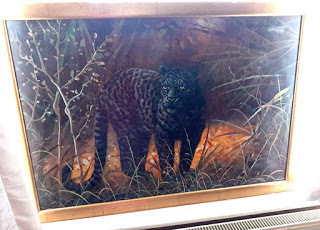 Maxine's painting when photographed by a window (© Maxine Pearson)
Maxine's painting when photographed by a window (© Maxine Pearson)
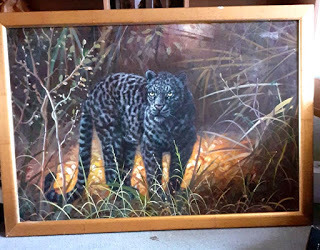 Maxine's painting when photographed on the floor (© Maxine Pearson)
Maxine's painting when photographed on the floor (© Maxine Pearson)
So what could Maxine's mystifying cat be? Its build and face are those of a big cat, by which I mean a species belonging to the genus Panthera, and most closely resemble a leopard's or jaguar's. Its coat colouration and pattern, conversely, are fundamentally different from those of a leopard or jaguar. Instead of sporting the leopard and jaguar pelage's typical golden background colouration, Maxine's cat is uniformly grey. And instead of displaying the leopard's familiar rosette markings (also exhibited by the jaguar, but which additionally sports a central spot within each rosette that is lacking in the leopard's coat pattern), the pelage of Maxine's cat consists of a heavy mottling of single polka dots, not arranged into rosettes, but which in places merge together to yield streaks and short stripes, especially on the limbs and dorsal region.
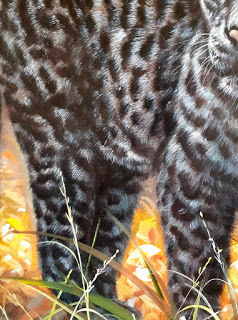 Close-up of the painted cat's limbs, revealing merged spots (© Maxine Pearson)
Close-up of the painted cat's limbs, revealing merged spots (© Maxine Pearson)
I noted earlier here that the only known African cat that possesses a pelage similar to that of Maxine's mystery cat is the spotted grey morph of the African golden cat – a polymorphic species that exists in a range of different coat colours and patterns, including unspotted red, gold, grey, and black, plus spotted red, gold, and grey. Although most common and widely distributed in West Africa, it is now known to exist in Central and East Africa too.
For morphological comparison purposes, here are two African golden cat skins, the left-hand one representing its spotted grey morph, the right-hand one its spotted golden morph.
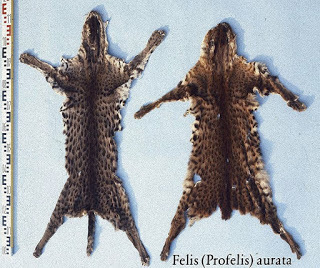 The skin of a spotted grey specimen of African golden cat (left) and the skin of a spotted golden specimen of African golden cat (right) (public domain)
The skin of a spotted grey specimen of African golden cat (left) and the skin of a spotted golden specimen of African golden cat (right) (public domain)
And here is a close-up of the fur patterning of Maxine's mystery cat as depicted in the painting:
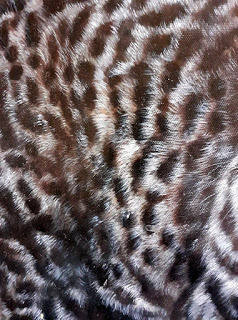 Close-up of the depicted mystery cat's fur patterning (© Maxine Pearson)
Close-up of the depicted mystery cat's fur patterning (© Maxine Pearson)
As you can see, there is certainly a resemblance.
To see what a spotted grey specimen of the African golden cat looks like in life, click hereto view a photograph of one such animal that was snapped using a trail cam during a study of this elusive species' ecology and conservation by Laila Bahaa-el-din as part of her 2015 PhD in the School of Life Sciences at the University of KwaZulu-Natal in Durban, South Africa. And click hereto download the entire paper containing this photo. You will see straight away, however, that whereas their coat colour and patterning are similar, the golden cat's head is very different in both shape and markings to that of Maxine's cat, which, as already noted here, is leopardine or jaguarine.
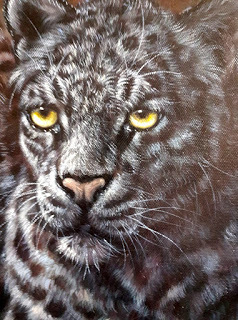 Close-up of the leopard-like or jaguar-like face of the mottled mystery cat depicted in Maxine's enigmatic painting (© Maxine Pearson)
Close-up of the leopard-like or jaguar-like face of the mottled mystery cat depicted in Maxine's enigmatic painting (© Maxine Pearson)
Equally, it is its unique combination of leopard/jaguar-like head and grey mottled pelage that distinguishes this portrayed cat from any felid on record from anywhere outside Africa too.
So how do we explain this painting? Is it an attempt by someone with cryptozoological knowledge to depict the likely appearance in life of the nunda? Or might it portray some exceedingly rare, freak version of the leopard or jaguar, both of which are well known for the great variation of their coat colour and patterning? Yet I have never seen an example of either in which the rosettes have broken up into single or merged spots (although I have seen in both species the opposite extreme, where the rosettes have merged to yield an extraordinarily beautiful, striking pelage adorned with stripes and swirls greatly resembling that of the cheetah's rare king cheetah variant). Or is it simply a portrayal of a fantasy felid, not based upon any real specimen but originating entirely from the artist's own imagination? At this stage, we simply do not know, but it is certainly most intriguing that the cat that it depicts should so closely recall a documented mystery cat from the same continent.
If anyone reading this ShukerNature article has any knowledge concerning this painting's origin and/or artist, or any thoughts that they would like to offer regarding the possible identity of the cat depicted in it, please post them below this article – Maxine and I would be very interested to read them!
My sincere thanks indeed to Maxine Pearson for so very kindly sharing her wonderful discovery and photographs of it with me, and for permitting me to document it here.
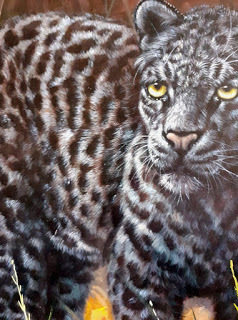 A close-up of the flank markings of Maxine's mystery cat as depicted in the painting (© Maxine Pearson)
A close-up of the flank markings of Maxine's mystery cat as depicted in the painting (© Maxine Pearson)
CHARLIE BOYS ANGELS: Here is a description of what this very worthy charity is all about, quoted from their official Facebook page (click here to visit it):
Charlie Boys Angels support homeless and vulnerable individuals with their animals in the Southend and surrounding areas of Essex by providing essential items, access to free veterinary treatment and support to find pet friendly accommodation.
This page was set up to help us get our name out there and the fantastic work that we do and is dedicated in memory of a beautiful white staffie called Charlie Boy, let us tell you his story...
Charlie Boy and his owner were sadly made homeless back in November 2016 and it was around this time that this group was founded to help him with a skin complaint. Tragically in January 2017, they were both attacked on the street – Charlie Boy jumped up to protect his owner and was fatally stabbed, he died a short time later.
After his death, our group and the local community was filled with heartfelt memorials for this brave boy who had sacrificed his life for his human so it was then that it was decided that we would continue our work in his memory to help others just like them who are homeless and vulnerable with their animals and also those without.
We provide:
- Animal items such as food, blankets, treats, collars, leads, coats, toys, flea & worm treatment etc.
- Clothing items such as Jackets, Jumpers, Hats & Scarves, Gloves etc.
- Help to find pet friendly accommodation
- Help towards the cost of vet treatment
- Foster Care in Emergency Situations
We want to prevent this tragic incident from ever happening to anyone else in the future and so far we have achieved this, making sure that everyone we work with are safe and have everything they need to look after their companions.
4 years into our work, we have now joined in partnership with the Aspirations Program whose mission is to empower individuals on their journey of recovery from the harmful effects of active addiction – working together to make a difference to people’s lives.
We do not receive any government grants and rely solely on support from the public and fundraising to help us continue the work that we do and keep our vet treatment free and accessible to those who need it the most. We have our current Facebook pages including our fundraising page.
We will add link into the comments below for ease.
We also have our wish lists on Amazon, again we will place a link below. Please share this post as it’s extremely difficult to arrange fundraising at this time due to current restrictions.
If you wish to kindly make a donation towards the work we do, you can do so by Bank Transfer directly to the below details as unfortunately we no longer have access to a PayPal account – all donations are so greatly appreciated.
Account Name: Charlie Boys Angels
Sort Code: 20-19-97
Account Number: 90007625
Reference: Donation
Thank you most sincerely for reading this – Karl.
March 20, 2021
ON THE TRAIL OF NEW GUINEA'S STRIPED FELINE MYSTERY BEASTS
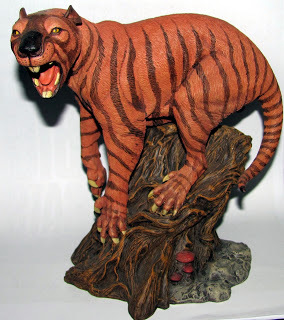 Spectacular figurine portraying the possible appearance in life of the Queensland tiger or yarri if real and constituting an extant species of thylacleonid; owned by Australian cryptozoologist Rebecca Lang, it was created by Sean Cooper and constructed/painted by Jeff Johnson (© Rebecca Lang/Sean Cooper/Jeff Johnson)
Spectacular figurine portraying the possible appearance in life of the Queensland tiger or yarri if real and constituting an extant species of thylacleonid; owned by Australian cryptozoologist Rebecca Lang, it was created by Sean Cooper and constructed/painted by Jeff Johnson (© Rebecca Lang/Sean Cooper/Jeff Johnson)
There are no native marsupial or eutherian felids living in New Guinea – or are there?
The exceedingly elusive and still-unconfirmed Queensland tiger or yarri is a large, striped, cat-headed mystery beast long claimed (but still not confirmed) to exist in this region of Australia, and some cryptozoological researchers have speculated that if it does indeed exist, it may conceivably be a living species of thylacoleonid or marsupial lion, officially believed to have become extinct many millennia ago (see my three mystery cat books for more details). Referring to this feline cryptid in their book The Wild Animals of Australasia (1926), Albert S. le Souef and Henry Burrell included the following tantalisingly brief snippet:
We have had a striped carnivorous animal described from Northwest Australia, and Lord Rothschild states, from native reports, that a similar animal exists also in New Guinea.
 Lord Walter Rothschild (public domain)
Lord Walter Rothschild (public domain)
During the late 1800s and early 1900s, eminent British zoologist Lord Walter Rothschild FRS (1868-1937) amassed a truly immense personal museum of natural history specimens (the largest ever owned by a private individual), and he sponsored many naturalists and collectors to scour the world (including New Guinea's vast little-explored jungle realms) in search of more. These searches in turn led to the scientific discovery, and subsequent formal description by Rothschild, of many important new animal species. His museum subsequently formed the basis of what is now Tring Natural History Museum in Hertfordshire, England which is the repository of much of the vast collection of bird specimens owned by London's Natural History Museum.
Over the years, I've read a fair few of Rothschild's papers and books, but so far I have yet to uncover in any of his publications the source of the above-quoted information attributed to him by le Souef and Burrell. So if any reader happens to know this source, I'd be very grateful indeed to receive details.
Moreover, Rothschild's rumoured riddle is not the only feline cryptid (indeed, not even the only striped feline cryptid) reported from New Guinea. I know of at least two others, very different from one another morphologically, but equally memorable – albeit once again for very different reasons.
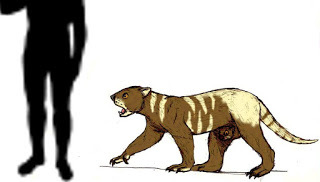 Are there striped (possibly even marsupial) feline cryptids awaiting formal discovery in New Guinea? (© Connor Lachmanec aka TheMorlock)
Are there striped (possibly even marsupial) feline cryptids awaiting formal discovery in New Guinea? (© Connor Lachmanec aka TheMorlock)
I documented the first of these latter two in my book Cats of Magic, Mythology, and Mystery (2012). On 11 November 2011, Australian cryptozoological researcher Malcolm Smith's internet blog, Malcolm's Musings, contained a fascinating post in which he reported that one of his neighbours, Esther Ingram, who had been born to missionary parents in New Guinea, once observed an apparent mystery cat at close range there when revisiting this great island mini-continent as an adult. Her sighting occurred one evening during December 1999/January 2000 at a distance of only 20 yards away when the creature emerged from some jungle and crossed the road ahead while she and her father were being driven by her foster-brother in the Eastern Highlands province of Papua New Guinea (PNG). According to Esther's description as recorded by Smith, the creature was:
…very solidly built, and the head-body length was about five feet. Both Esther and her father were amazed at how huge it was...Esther, in particular, made an attempt to study as many details as possible. (Remember, it was very close.) The basic colour was white, with ginger "trimmings" on the tail and ears. Pale gingery, vertical stripes, not terribly well delineated, appeared on the sides, but they did not extend to the back, or dorsal surface, which was completely pale. She specifically noted that the forepaws were cat‐like, rather than (say) hoofed like a goat's. She didn't get a glance at the rear paws. The tail was ginger and very long, hanging to the ground. I enquired about bushiness etc, to establish a comparison with a dog's. She said it was a bit coarser or fluffier than the body, but not much. On the body itself, the fur was smooth. The head was broad, short, flattish, and definitely cat-like. It did not protrude like a dog's. The ears were ginger, mottled with white, and hung down. They were not as long as a spaniel's, but they were definitely long and rounded, and gave every indication of being naturally floppy. It was this feature which amazed both of them (and me as well, as it doesn't sound anything like a cat's). Esther also thought she saw whiskers.
Very intrigued by Esther's account, Smith contacted Australian mammalogist Dr Tim Flannery, an expert on New Guinea fauna, and asked his opinion as to what she may have seen. Dr Flannery deemed it likely that her mystery beast had been a tree kangaroo, but Esther, born and raised in New Guinea and regularly returning there for visits as an adult, was very familiar with the appearance of such animals, and did not agree with this identification of the creature that she had seen. Could it have been the New Guinea version of the Queensland tiger as claimed by Rothschild?
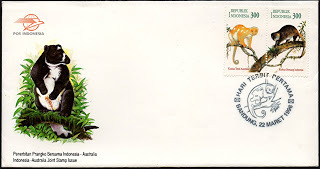 Issued jointly in 1996 by Indonesia and Australia, a philatelic First Day Cover featuring on its left-hand side an illustration of the dingiso – a very distinctive species of black-and-white tree kangaroo native to New Guinea's Indonesian western half, yet which remained undiscovered and undescribed by science until as recently as the 1990s (© Indonesian Postal Service/© Australian Postal Service – reproduced here on a strictly non-commercial Fair Use basis for educational/review purposes only)
Issued jointly in 1996 by Indonesia and Australia, a philatelic First Day Cover featuring on its left-hand side an illustration of the dingiso – a very distinctive species of black-and-white tree kangaroo native to New Guinea's Indonesian western half, yet which remained undiscovered and undescribed by science until as recently as the 1990s (© Indonesian Postal Service/© Australian Postal Service – reproduced here on a strictly non-commercial Fair Use basis for educational/review purposes only)
With no known large-sized mammalian predators other than imported canine forms, such as the nowadays exceedingly rare New Guinea singing dog, ecologically speaking it would not be inconceivable for an elusive feline cryptid to thrive here, plentifully supplied with wallabies, tree kangaroos, possums, rodents, bird life, and other potential prey species. How ironic it would be if the Queensland tiger, or something very like it, was ultimately discovered not in Australia but instead in its more mysterious northern neighbour, New Guinea.
The third of this latter island's reported feline cryptids is more famous, but for all the wrong reasons. Supposedly referred to locally as the moolah, it is just one of several very remarkable beasts that were said to exist here by Captain J.A. Lawson in his notorious book Wanderings in the Interior of New Guinea (1875). According to Lawson, he had landed here in 1871, and among his truly extraordinary alleged discoveries were the world's highest mountain (dubbed by him Mount Hercules, and far taller than Everest, yet which could be climbed in just a day!), very large monkey-like ape-men, enormous herds of deer and buffalo numbering in their thousands, the world's tallest tree, flightless birds resembling ostriches or emus, and, his pièce de resistance, the moolah, a specimen of which he supposedly shot and which was ostensibly one and the same as India's Bengal tiger! Here is Lawson's description of his freshly-killed moolah:
This animal was formed exactly like the Indian tiger, nor was it inferior in size; but it was a much handsomer creature. It was marked with black and chestnut stripes, on a white, or nearly white, ground. Its length from the nose to the root of the tail was seven feet three inches.
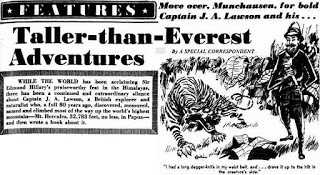 The opening headlines and accompanying sketch from an extensive article (click here
to access it
) recalling the Munchhausenesque history of Captain J.A. Lawson that appeared in Sydney's Sunday Heraldnewspaper on 23 August 1953 (© Sunday Herald, Sydney – reproduced here on a strictly non-commercial fair use basis for educational/review purposes only)
The opening headlines and accompanying sketch from an extensive article (click here
to access it
) recalling the Munchhausenesque history of Captain J.A. Lawson that appeared in Sydney's Sunday Heraldnewspaper on 23 August 1953 (© Sunday Herald, Sydney – reproduced here on a strictly non-commercial fair use basis for educational/review purposes only)
On fundamental zoogeographical grounds alone, however, Lawson's claims regarding the existence in New Guinea of the moolah and the other creatures listed above were arrant nonsense.
Yet, incredibly, for some years afterwards they were widely accepted as gospel, until continued explorations of New Guinea finally confirmed the entire content of Lawson's book to be fictional – indeed, a veritable Munchausenesque satire on the whole concept of Victorian exploration – rather than anything remotely factual.
As for the true identity of the mysterious Captain himself, this has never been conclusively established. However, the most popular suggestion is that Lawson was actually Robert H. Armit (1844-?), a lieutenant in the Royal Navy with experience as an assistant surveyor in Australian waters, and later Honorary Secretary of the New Guinea Colonising Association.
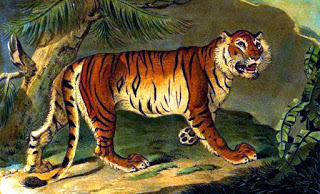 Indian tigers frequenting the forests of New Guinea?? I don't think so!! (public domain)
Indian tigers frequenting the forests of New Guinea?? I don't think so!! (public domain)
March 18, 2021
THE LOCH NESS MONSTER AND THE SURGEON'S PHOTOGRAPH - A HOAX, OR A HOAXED HOAX? PRESENTING MY PERSONAL OPINION
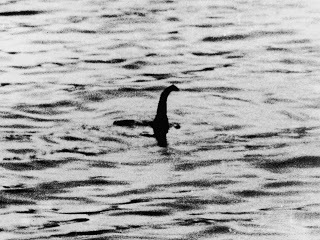 The familiar cropped version of the Surgeon's Photograph (Fortean Picture Library)
The familiar cropped version of the Surgeon's Photograph (Fortean Picture Library) The Loch Ness Monster (or LNM for short) has been associated with numerous cryptozoological controversies down through the decades, especially ones involving procured visual evidence allegedly supporting its reality. However, the most infamous of these latter controversies concerns the so-called 'Surgeon's Photograph', whose image of what is reminiscent of a head and slender neck protruding up through the water is everyone's immediate mental picture of Nessie whenever the subject of Loch Ness is aired.
According to the official history of this iconic image, it was the best one of four photos (two of which did not come out when developed) that Lt-Col. Robert K. Wilson (1899-1969), a gynaecologist based in London's medically-prestigious Harley Street, claimed to have snapped after seeing something on the loch from a spot about 2-3 miles northeast of Invermoriston during a car journey along the A82 road one morning in April 1934. After then taking the photographic film containing them to be developed at a chemist's shop in Inverness, he sold them to London's Daily Mail newspaper, which on Saturday 21 April 1934 published what became dubbed as the Surgeon's Photograph (in homage to Wilson's profession), causing a sensation that ensured this picture's lasting fame both within and far beyond the realms of cryptozoology. (Incidentally, in the Daily Mail's article of 21 April it quoted Wilson as stating that he had snapped the photos during his visit to the loch "on Thursday", thereby confirming the precise date of his visit as having been Thursday 19 April – assuming of course that we can believe Wilson's testimony... – much more about this later!)
Sceptics have variously attempted to dismiss the photograph's 'head-and-neck' image as that of a bird, or the tail of a diving otter, or even as the dorsal fin of an out-of-place killer whale or a giant sturgeon. During the 1990s, however, two rival allegations were made that sought to expose this photo as a blatant hoax – but as these allegations are mutually exclusive, only one (if any) can be correct; and, to be perfectly frank, I am not persuaded by the claims for either of them!
Before I go any further, however, I wish to stress that what I am presenting in this ShukerNature blog article concerning the evidence (such that it is) on offer for the Surgeon's Photo being a hoax is my personal opinion, nothing more. Consequently, it should not be thought of as a fact, because an opinion is not a fact, and cannot be a fact.
In 1992, the Danish weekly magazine Hjemmetpublished an article in which musicologist Prof. Lambert Wilson, a former conductor of the Aberdeen Symphony Orchestra, asserted that he had constructed a 'sea serpent' swimming mask, featuring the famous head and neck configuration in the 'Surgeon's Photo', with tiny eyeholes enabling him to see, which he had worn while swimming in the loch on a day in late summer 1934. According to his story, this is what the London surgeon, coincidentally sharing the professor's surname, had seen and photographed. However, all other accounts concerning the taking of this photo placed the date in question in April, not during the summer (with the Daily Mail having published it in April too). In any case, the very concept of someone swimming around in the loch with the model of a Nessie perched on top of their head is one for which I personally would be most reluctant to stick my neck out (so to speak!).
The second, far more serious allegation received widespread publicity during March 1994, when Loch Ness researchers David Martin and Alastair Boyd announced that, only a year before he died in November 1993, expert model-maker Christian Spurling (1904-1993) had confessed to them that the photo's image was actually that of a roughly 1-ft-tall 'head-and-neck' model – constructed by him from plastic wood in early 1934, then attached to the conning tower of a roughly 14-in-long clockwork toy submarine (later painted grey and serving as the fake monster's largely submerged body) that had been purchased at Woolworths in Richmond, Surrey, in southern England, by his stepbrother, Ian Wetherell (1912-1986). According to Spurling, this bizarre-looking mini-craft monster was then secretly photographed (and afterwards sunk) in the loch by a member of a team of hoaxers (which had included himself, but more about them later) – not by Wilson, despite his public statements. (Incidentally, Spurling had initially made his confession in February 1991, but only to Martin, visiting with his wife Jane, who did not tape it; in July 1992, however, he made it again, this time to Martin and Boyd together, who did tape it.)
Apparently a prankster very fond of practical jokes, and supplied by the hoaxers with full details concerning the head/neck model affixed on top of the toy submarine, Wilson had supposedly been recruited by them merely to state publicly that it was he who had taken the photos, his professional status as a highly respectable surgeon guaranteeing that these pictures would by association be taken seriously, and ensuring that the involvement of the hoaxers would remain concealed. Martin and Boyd subsequently documented their investigations that had led them to support Spurling's startling claim in an absorbing book, Nessie: The Surgeon's Photo Exposed (1999).
Of especial note at this point is that a long-overlooked article uncovered by Martin and Boyd that had appeared in London's Sunday Telegraph newspaper back on 7 December 1975, and had been written by 'Mandrake' (the pen-name of one Philip Purser), had actually claimed that Ian Wetherell had admitted to 'Mandrake' that while in the company of his film director/big-game hunter father Marmaduke ('Duke') Wetherell (1886-1939) and an insurance broker friend called Maurice Chambers (d. 1944), he had taken about five photos with a Leica camera of a small toy submarine bearing a head/neck model made of rubber tubing and just a few inches tall in an inlet of the loch before his father, Duke, sank this craft using his foot when a water bailiff showed up, with the clearest of these pictures becoming the Surgeon's Photo. Curiously, however, no mention was made of Wilson. No less intriguing, additionally, is that this potentially significant newspaper article signally failed to be mentioned in any Nessie-related publication for almost two decades. More about this article a little later. Meanwhile, both of the Wetherells (and Wilson too) were dead by the time that Spurling made his own alleged confession, so they could not be questioned about it following its public release.
Spurling claimed to Martin and Boyd that he had been requested to produce this monster model by his stepfather Duke and stepbrother Ian (who, Spurling alleged, also recruited Wilson as the fourth member of their conspiracy) – in order to avenge the then-recent public humiliation suffered by Duke when he rashly identified as genuine some footprints found on the shores of Loch Ness that were soon afterwards exposed as crude fakes. They had been produced by someone using an ashtray (not an umbrella stand, as claimed in many other publications) set into the stuffed foot of a hippopotamus! Bearing in mind, however, that the Wetherell family actually owned such an object, it is by no means unlikely that Duke himself was the footprint hoaxer (although it has never been definitely proved, some investigators have openly claimed this to be so, especially as Duke's fondness for trickery was apparently well known, and Spurling himself inferred it to Martin and Boyd, calling his stepfather a Walter Mitty character), but had not anticipated the ridicule that would rebound upon him. Consequently, as far as the Wetherell/Wetherell/Spurling family trio was concerned, there could be no better way of seeking retribution for this humiliation of one of their own members than to discredit the monster itself.
Sadly, the media's coverage in 1994 and since then of this supposed hoax was and continues to be largely uncritical (indeed, it is still widely if mistakenly assumed to have been conclusively proved). So it was left to some astute newspaper readers and also various cryptozoological investigators on social media and elsewhere to point out its array of inconsistencies and contentious issues, to which I have added various concerns of my own too. They can all be collectively summarised below as follows:
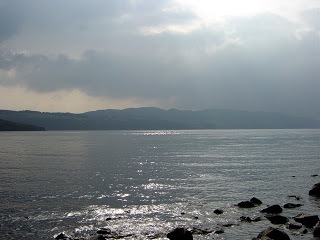 Loch Ness, misty and mysterious – has there ever been a single specific location that has engendered so much conjecture, contention, and confusion in modern times? (public domain)
Loch Ness, misty and mysterious – has there ever been a single specific location that has engendered so much conjecture, contention, and confusion in modern times? (public domain)
First and foremost is a statement that I shall deliberately reiterate on a regular, specific basis throughout the present ShukerNature blog article of mine, because it is absolutely integral to this cryptozoological case and therefore needs to remain uppermost in everyone's mind. Namely, there is absolutely no physical, tangible, direct evidence that the head/neck-bearing toy submarine ever existed, only anecdotal, testimonial evidence in the form of verbal conversations and written communications that, as will be seen, contain all manner of conflicting claims and details.
But why isn't anecdotal evidence sufficient by itself to prove a hoax if a hoax has indeed occurred? The intrinsic problem is that there is generally no way of independently confirming how truthful or accurate such evidence is by itself. If we are listening to someone describing an occurrence that they claim to have experienced or we are reading a written description of what they claim to have experienced, we cannot know for certainwhether all or indeed any of that description is genuine. We weren't there, we didn't see or hear what the claimant is claiming to have seen or heard – we don’t even know if the claimant himself/herself was where they claimed to be. Their entire testimony could be a lie. And even if they are being truthful, we don't know how accurate their description is, how gifted their powers of description are. Are they given to unconscious exaggeration when describing something, for example, or do they omit essential details because they don't realise that those particular details are essential? How extensively have their brain and sensory organs filtered their experience? We simply cannot know for certain. Similarly, even if two different people provide similar descriptions of an event that they both experienced, how can we know for sure whether or not they have colluded in any way before providing their testimonies, especially if they are work colleagues, neighbours, friends, or family members who are in contact with one another? The most that we can do in these situations is formulate an opinion as to whether we believe their testimony to be true, false, or truthful/untruthful in parts, but we cannot determine conclusively whether their testimony is true, false, or truthful/untruthful in parts if all that we have is their testimony. In contrast, a physical, tangible piece of evidence can, if for example it is a section of an animal carcase or even just a clump of hair, enable DNA samples to be extracted from it in order to determine the taxonomic nature of the animal from which the section of carcase or clump of hair came from. Comparative hair analyses can also be conducted with it, and so on.
Back now to the head/neck-bearing toy submarine. According to the alleged hoaxers' claims, this curious mini-craft was sunk by one of them (Duke) in the loch after having been photographed on it and was therefore placed for all time beyond the reach of any kind of direct physical examination. How very convenient! Yet even if it was indeed real and truly had been sunk in the loch, it has probably long since been broken apart by underwater currents and buried who knows where beneath the loch bottom's thick layer of mud, ooze, and silt. Either way, there can never be an examination of the hoax claim's key component. But that is not all.
No photographs of this mini-craft snapped with or without any of the supposed hoaxers positioned alongside it before it was allegedly placed on the loch and then sunk are known to exist either, nor are any preliminary sketches of it with the head/neck model attached or of the head/neck model itself, nor even any preparatory notes about how the latter model might be produced and attached. Not even the shop receipt from Woolworths where the original toy submarine was supposedly purchased exists, nor does any manufacturer's carton or box in which it would have been packaged and sold – and so on, and so forth. Instead, all that IS available to assess that has any specific bearing upon whether this extraordinary model-bearing craft was truly a reality is anecdotal, testimonial, circumstantial, indirect evidence, nothing else at all. Please keep this remarkable but deeply unsatisfactory, unpromising situation firmly in mind – it is absolutely vital.
Moving on: the type of small clockwork toy submarine available for use by Spurling at that time (only 14 in or so long, according to his confession) could not have supported such an unwieldy structure as (according to Spurling once again) a roughly 1-ft-tall head/neck model without the submarine being in serious danger of overbalancing (due to the attached head/neck model giving it a very high centre of gravity), especially when placed on a medium as mobile as water. The usual way to prevent such a problem occurring would have been to place ballast inside the submarine – but this would have promptly sent it plunging down beneath the water! True, in more recent times an ITN film crew and a Japanese film crew successfully floated what they considered to be replicas of Spurling's head/neck-bearing toy submarine. But as no-one involved in the creation of these replicas could actually examine or even view the latter craft (always assuming of course that it ever existed to begin with!), having to rely instead entirely upon Spurling's verbal description of it provided by him before he had died, and a picture of a toy submarine shown to him by Martin and Boyd that he claimed to be similar to the one that he had used, such accomplishments by the two teams clearly are by no means as impressive as they might outwardly seem to be.
Speaking of overbalancing: Spurling claimed that his alleged head/neck-bearing toy submarine had been fitted with a metal (lead) strip or keel to act as a counterbalance. Yet without anyone being able to physically examine the submarine, his claim is just that – a claim, i.e. anecdotal, unsubstantiated by any tangible evidence, as is everything else too, therefore, that has been said about this supposed object's structure by various people down through the years. Put another way, it is futile to quote Spurling's claim that a counterbalancing metal strip was present as proof that the submarine was stable, because this 'proof' originates from within the physically-unsubstantiated claim that the submarine actually existed to begin with, not from outside it, i.e. independent of it.
In any case, it should go without saying that anyone making up some elaborate fictitious story of a head/neck-bearing toy submarine having been created by them and used for the photo would definitely have the common sense to also claim that a counterbalancing strip was present – they would certainly realise that not to do so would yield a gaping, readily-visible hole in their story. If any hoax is to succeed or at least be convincing, it has to be well thought out in advance, in a bid to ensure that every possible flaw or gap in it is identified and plugged, before actually putting it into practice.
There have also been claims by some that wires are visible in the Surgeon's Photo that could be holding this alleged counterbalance strip in place, but others (including me) have been unable to discern any such structures. Yet even if they are present, the submarine (always assuming, as ever, that it had indeed originally existed) cannot be examined to confirm whether or not they really are wires. So the most that can be said about these reputed structures (should they genuinely exist and not prove to be as illusive or selectively visible as the emperor's new clothes in the famous fairytale by Danish storyteller Hans Christian Andersen!) is that they seem wire-like. However, 'wire' and 'wire-like' are not necessarily the same thing at the best of times, and certainly not in this particular instance. Moreover, without any physical evidence existing for the submarine's own reality, any discussion appertaining to whether such structures, if truly present, are indeed wires is moot anyway.
The Surgeon's Photo shows the ostensible head and neck surrounded by ripples. Yet surely this is not to be expected if the craft were moving at the time of being photographed, as was variously claimed by Wilson (in a letter of 24 May 1955 to LNM authoress Constance Whyte, for example). If it were moving, wouldn't there be a wake trailing behind it instead? Having said that, this line of argument necessarily assumes that Wilson actually did snap the photos, which as already seen is very far from certain, but even if he didn't snap them and his supposed photographic session at the loch was entirely fictitious, you'd still think that when inventing the story of his non-existent session he'd at least have had the nous to ensure that his verbal description of the head-and-neck object and its behaviour corresponded with what can be seen of it in the photo.
Some investigators have claimed that the 'head-and-neck' object seen in this photo looks to be rather more than 1 ft tall. Based upon a comparison of the length of adjacent wind waves (with the wavelength estimated from modern results on wind waves and contemporaneous weather information), oceanographers Prof. Paul LeBlond and Dr Michael Collins calculated in a research paper of 1987 published within the International Society of Cryptozoology's peer-reviewed scientific journal Cryptozoology that the neck's height above the water level may have been around 4 ft, although this has since been disputed via counter-analyses prepared by others.
So far, I have focused my attention entirely upon the Surgeon's Photograph, but as noted at the beginning of this ShukerNature article, a second (albeit much less famous) photo, also allegedly snapped by Wilson of the head-and-neck object, exists too. Yet how can the head/neck model-bearing toy submarine identity explain this second photo, bearing in mind that the head-and-neck image depicted in it has a very different outline and orientation from those of the image in the Surgeon's Photo? Remember that Spurling's supposed head/neck model would necessarily have been of rigid, inflexible construction in order for it to retain its form while being photographed, and would therefore have been unable to change either its shape or its orientation. Two contrasting explanations have been proposed – either the photographed head-and-neck object was part of a genuine living creature, not a model, and had moved its position and orientation between the taking of the two photos; or the second photo did not depict the same object as was present in the Surgeon's (and may not even have been taken at the same time and/or location). Unfortunately, there seems no way of determining conclusively which (if either) of these explanations is the correct one; there is some circumstantial, testimonial evidence presented in Martin and Boyd's book indicating that the latter explanation may be correct, but, as ever, no hard, direct, physical evidence.
Significantly, there are various noteworthy discrepancies between Ian Wetherell's confession as contained in the 'Mandrake' article of December 1975 and Spurling's own confession as given by him to Martin and Boyd, which do not appear to have been highlighted anywhere before my own investigations into this matter. According to Wetherell, the hoaxers were himself, Duke, and Chambers (but no mention of Wilson), whereas according to Spurling they were himself, Wetherell, Duke, and Wilson (but no mention of Chambers). So why was Wilson absent from Wetherell's confession (despite his having supposedly played such a key role in their hoax), and Chambers from Spurling's? In the 'Mandrake' article, Wetherell is quoted as saying: "I took about five shots with the Leica", but if so, where are the others? Did they not come out? Only the Surgeon's Photo and the second photo are known to exist. Also in the article, the head/neck model is said by Wetherell to have been made from rubber tubing, whereas Spurling claimed that it was made from plastic wood. Wetherell also claimed that the head/neck model-bearing toy submarine was "only a few inches high", whereas Spurling stated that it was "about 12 inches". How can these discrepancies be explained – a whole succession of memory lapses, or the fundamental failure of two stepbrothers to synchronise their stories before going public with them?
Alarm bells also rang in my head when I read Spurling's claim made by him to Martin in 1991 that he had never seen the Surgeon's Photo either in newspapers or on TV since 1934 – a jaw-dropping assertion that even Martin freely admits was met by him with almost disbelief. Although I would question Martin and Boyd's statements in their book and on its back cover that this iconic image is possibly/arguably the most famous photograph in the world, there is no question that it is definitely among the most familiar, memorable, and instantly recognisable ones, appearing in innumerable publications, TV programmes, and other media outlets. Short of spending one's days atop some aloof, inaccessible mountain peak or deep underground in some stygian cave, it seems highly unlikely that anybody could go almost 60 years, especially during much time spent in Britain, without seeing this photo somewhere even once. And when that 'anybody' just so happens to be someone as intimately linked (and hence psychologically attuned) to this particular photo as Spurling was (regardless of the precise nature of that link), I personally find wholly unsatisfactory and unconvincing his attempt to explain his extraordinary allegation made by him to Martin of never having seen the photo since 1934 by giving the impression that this was simply because he had no interest in it. You don't have to be interested in something in order to see it, especially if that something happens to be as ubiquitous as this particular photo. Quite frankly, Spurling's unrealistic allegation readily brings to my mind the following famous quote from Shakespeare's play Hamlet: "The lady doth protest too much, methinks".
In addition, I am always very wary of 'death bed' confessions. Why did Spurling wait so long, especially as the 'Mandrake' article containing his stepbrother's supposed confession had already been published way back in 1975 anyway? Even the faking of a photograph that went on to become immensely iconic is not a crime in itself (and publicly releasing via a published newspaper article a supposed confession to having done precisely that certainly hadn't troubled Ian Wetherell). Indeed, if anything, the release of the 'truth' while the hoaxers still lived might well have guaranteed them fame and lucrative financial gain (or at least it might have done for Wetherell had the article containing it not instantly sunk into absolute oblivion for two decades before finally resurfacing, by which time he had died).
In their book, Martin and Boyd also put forward as proof that the Surgeon's Photo was faked a very odd claim made in a letter written on 3 November 1970 by a Major Egginton, one of Wilson's friends, to a then-upcoming Nessie researcher/author/TV newsreader Nicholas Witchell. Egginton alleged that Wilson had told him that this photo had been faked by a keen amateur photographer friend of his (unnamed by Wilson but presumably Ian Wetherell?), who had first of all snapped a photo of the loch and then, once back home, had superimposed a LNM model (presumably Spurling's?) onto the photographic plate. In other words, Wilson was seemingly claiming to Egginton that the Surgeon's Photo was actually a composite of two separate images. Martin and Boyd have claimed that this letter plus two slightly later ones also written by Egginton to Witchell (though these add little to what was already contained in the first one) and retained by Witchell, constitute the most important evidence against the Surgeon's Photo that has ever been uncovered. Yet in reality this is yet again only anecdotal evidence – a persistent yet highly frustrating, deeply unsatisfying theme running throughout this saga. In addition, few photographs have ever received such in-depth scrutiny as the Surgeon's Photo, so if it had indeed been created by superimposing one image upon another one back in the early 1930s, when photographic techniques were far less sophisticated than they are today, I feel sure that someone would have revealed this by now.
Moreover, the most surprising element of this particular aspect of the case, yet one that Martin and Boyd may not have realised, as they have apparently not focused upon it during their own investigations, is that if Egginton's claim is true, then a crucial component of the much-vaunted 'confessions' of Wetherell and Spurling is false. This is because the Egginton and the Wetherell/Spurling testimonies do not support one another. On the contrary, they fundamentally contradict each other.
After all, if the Surgeon's Photo were indeed a single photo resulting from a Spurling-constructed head/neck model borne upon a toy submarine being directly photographed by Ian Wetherell in the water at the loch and then sunk there by Duke, simple logic dictates that it couldn't have also been a composite photo created by Wetherell at home by superimposing the head/neck model's image upon the plate of an earlier-snapped photo of the loch, because these two scenarios are mutually exclusive. Or have I misunderstood this completely? Here is the relevant extract from that first letter written by Egginton to Witchell, so judge for yourself:
His [Wilson's] friend…was a very keen amateur photographer who had taken a photograph of the loch and then at home had apparently superimposed a model of a monster on the plate.
It seems clear enough to me, and with any mention of a toy submarine bearing a head/neck model having been directly photographed at the loch being conspicuous only by its absence.
Worth mentioning at this point, incidentally, is that in the past there was also some public palaver as to whether plastic wood – the material claimed by Spurling (but not by Wetherell, who stated instead that it was rubber tubing) to have been used in creating the head/neck model – even existed as far back in time as 19 April 1934, when the Surgeon's Photo and the second photo were supposedly snapped. (Having said that, if Wilson didn't actually snap them himself, but was only hired by the hoaxers to say that he did, they could have conceivably been produced quite some time earlier, ostensibly by Ian Wetherell, judging from Egginton's recollection of Wilson's claim to him.) Anyway, after I began investigating this aspect, fellow cryptozoological researcher Scott Mardis kindly informed me that the Oxford English Dictionary gives the following pertinent quotation that dates from 1921: "This material…is named by the firm 'Plastic Wood'". Also, the first issue of the newly-relaunched version of the long-running weekly UK magazine Hobbies, which was published on 4 October 1930, contained an article entitled 'Plastic Wood and Its Many Uses'. And p. 25 of London's Daily Mirror newspaper for 21 February 1934 carried a recommendation for the use of Rawlplug Plastic Wood. Moreover, veteran LNM researcher Roland Watson has discovered an advertisement for plastic wood in the March 1928 issue of the periodical Popular Science. So it seems evident that plastic wood did indeed exist prior to the two photos being snapped, even if their snapping actually occurred quite some time prior to the 'official' date of 19 April 1934 claimed for them by Wilson.
And speaking of Wilson: lastly, but in my view crucially, Martin and Boyd's book has provided an absolutely invaluable service in demonstrating just how unreliable Wilson's testimony was with regard to his supposed involvement in this highly contentious cryptozoological case. Via no less than a double-page listings table of discrepancies plus comparative analyses contained in their book's main text, they have painstakingly shown how Wilson's recollections varied considerably, not only in verbal conversations but also in written communications. Subjects upon which these recollections vary include: Wilson's precise location at the loch when he supposedly snapped the photos, and the time at which he snapped them; the prevailing weather conditions there; the ownership of the camera that he used, the reason why he'd taken it with him to the loch, and its position when he'd supposedly snapped the photos; his description of what he actually saw in the loch, and how it behaved; and its distance from him. Moreover, as already documented above, whereas he claimed to many people and media that it was he who had snapped the photos, he told Egginton that a friend had done so. A number of additional examples of Wilson's ambivalent memory are also given by Martin and Boyd in their book.
In fact, there is surely enough information available relating to Wilson's narrative inconsistencies by themselves to form the basis of a valuable, telling book on the Surgeon's Photo, without even needing to include supposed confessions centring upon an intangible head/neck-bearing toy submarine for whose existence there is not a shred of physical, conclusive evidence, especially as Wilson even reputedly claimed on occasion to various figures that the photo was a hoax. Needless to say, however, in an ironic example of being consistently inconsistent he yet again gave differing details about this claim to different people (in the earlier-mentioned letter of 4 May 1955 written by him to Whyte, Wilson even asserted that it may have been either the chemist who developed them or Wilson's own lady friend who had accompanied him to the loch who had hoaxed the photos!), leading to a farcical 'Boy Who Cried Wolf' scenario in which no-one can be sure any more about what (if anything) to believe from his various, varying assertions. In short, as a reliable source of information concerning the Surgeon's Photo, Wilson has in my view entirely discredited himself, and all hypotheses relating to this cryptozoological case that draw or are directly based upon his claims should therefore be automatically discounted as potentially unsound.
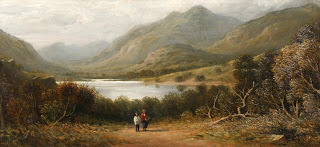 Loch Ness, exquisitely painted by a Follower of Samuel Bough, c.1877 (public domain)
My own personal opinion regarding this complex case is that the real hoax may well not have been the using of a head/neck-bearing toy submarine standing in for Nessie when snapping the Surgeon's Photo, but rather the claim concerning it. That is to say, the craft itself never actually existed – only the story of it did, a story invented (albeit with careless variations by them in their respective tellings of it) by two sons with a vested interest in despoiling Nessie's name, seeking revenge for the humiliation that their father had suffered as a result of the Nessie footprints debacle (but in so doing conveniently ignoring the fact that if, as seems highly likely, he'd hoaxed the footprints himself anyway, he was the author of his own downfall).
Loch Ness, exquisitely painted by a Follower of Samuel Bough, c.1877 (public domain)
My own personal opinion regarding this complex case is that the real hoax may well not have been the using of a head/neck-bearing toy submarine standing in for Nessie when snapping the Surgeon's Photo, but rather the claim concerning it. That is to say, the craft itself never actually existed – only the story of it did, a story invented (albeit with careless variations by them in their respective tellings of it) by two sons with a vested interest in despoiling Nessie's name, seeking revenge for the humiliation that their father had suffered as a result of the Nessie footprints debacle (but in so doing conveniently ignoring the fact that if, as seems highly likely, he'd hoaxed the footprints himself anyway, he was the author of his own downfall). After all, why go to the complicated and wholly unnecessary trouble of laboriously constructing a monster-mimicking mini-craft (one that by its very nature, moreover, is highly impractical and improbable) and perpetrating a hoax with it (thus facing all the attendant risks of being caught and castigated), when all that you need to do is to release many years later (in 1975 and 1991/2 respectively) a superficially plausible story of a hoax featuring a monster-mimicking mini-craft – a story that most likely can never be conclusively proved or disproved by anyone else afterwards, yet which will nonetheless cast for ever more a deep shadow of doubt not only upon a photo that has become over the years one of the most famous pieces of evidence put forward in support of the LNM's existence but also directly upon the LNM itself? (Some media accounts have indeed gone so far as to claim that because – albeit in their mistaken view – the Surgeon's Photo is a proven hoax, the entire LNM history is too.) Such a scenario would achieve the desired effect to the maximum extent yet via the minimum, simplest of effort. Parsimoniously, therefore, this is more likely to be the scenario that actually did occur (Occam's Razor). Or, to express this intriguing situation in a different but equally apposite manner: "The genius is simplicity – any damn fool can get complicated" – a Woody Guthrie quote that Martin and Boyd include at the very beginning of their book.
The ultimate irony here is that because there is no direct, physical, tangible, unambiguous evidence to confirm its existence, only anecdotal, the LNM is routinely dismissed out of hand by sceptics and critics of cryptozoology (as are most other cryptids by them, for that matter, and for precisely the same reason). Yet, paradoxically, they expect everyone to believe unquestioningly in a head/neck-bearing toy submarine for which there is no direct, physical, tangible, unambiguous evidence either, only anecdotal once again. To me, this seems logically inconsistent at the very least, if not downright hypocritical. And please don't quote to me that hackneyed statement about extraordinary claims requiring extraordinary evidence as a valid reason for discounting anecdotal evidence for the reality of cryptids while accepting it for the reality of the head/neck-bearing toy submarine. After all, if a claim featuring as inherently unstable and unlikely a craft as a toy submarine bearing a tall vertical head/neck model (thereby giving it an undesirably high centre of gravity liable to make it tilt over when placed on water, yet presumably lacking ballast for fear of sinking it) is not considered extraordinary (and thus requiring extraordinary evidence in order for its reality to be accepted, but which is noticeably absent), then what is?? Yet, disconcertingly, cryptozoology sceptics and critics do not seem to be remotely troubled by the absence of any physical evidence, let alone extraordinary evidence, when accepting the toy submarine claim. Double standards?
By the way: just in case anyone should be wondering whether I have any inherent bias in relation to the Surgeon's Photo that is influencing my own scepticism concerning the toy submarine confession claims of Wetherell and Spurling, let me make my position perfectly clear. No, I have no such bias, and this is why. There is no place in cryptozoology (or indeed anywhere else) for hoaxes, which serve only to destroy its credibility and make it vulnerable to criticism from mainstream researchers and sceptics. Consequently, as can be readily seen by browsing through the contents of this ShukerNature blog of mine as well as those of my many books and countless articles published elsewhere, whenever I discover physical, tangible, unequivocal evidence that a given cryptozoological case or specimen (whatever it may be) is a hoax, I lose no time in publishing full details concerning it, in order to expose its fraudulent nature for all to see. In turn, therefore, the reason why I currently cannot accept that, based upon the submarine-themed confessions, the Surgeon's Photo is a proven hoax is not due to any bias on my part but is instead because – as I have stated time and again throughout this present ShukerNature article – there is NO physical, tangible, unequivocal evidence for the submarine's existence. Simple as that. So I hope that this answers any possible bias-themed queries.
Having said all of that, it's time for me now to throw a curveball into the proceedings. Yes indeed, it may sound ironic, possibly even contradictory at first, but quite frankly I wouldn't be at all surprised if the Surgeon's Photo IS indeed a hoax! The 'head-and-neck' object depicted by it simply doesn't look like any living thing that I've ever seen, either personally or in pictures. The tail of a diving otter comes closest, but even that seemingly fails to yield the angled, head-like portion of the object in the Surgeon's Photo. Moreover, in order to make my position absolutely, unambiguously clear, I'll even go so far as to say that I'm not actually ruling out the toy submarine explanation per se. Confused? Please allow me to explain.
What it is that I AM ruling out is the toy submarine explanation in its current form, i.e. an explanation that – at the risk of boring you by repeating this mantra yet again – is based solely upon anecdotal evidence, with no physical, tangible evidence to hand for direct, physical examination. As I have shown earlier here, there are all manner of conflicting issues and contradictory aspects associated with this anecdotal evidence. True, at least some of them may not be wholly insurmountable – for example, perhaps at least portions of the Wetherell/Spurling confessions really are factual (with conflicting details due merely to memory lapses after all), perhaps there even really was a head/neck-bearing toy submarine (and which really was sunk in the loch and thereby rendered unavailable to any future physical examination) – but based solely upon the anecdotal evidence available, we cannot be certain, nor even fairly sure. This in turn means that media accounts and suchlike that have stated and continue to state categorically that the Surgeon's Photo is a proven hoax are mistaken, or, to put it bluntly, just plain wrong. And it is to make this fundamental, exceedingly important, yet all-too-frequently ignored or unrealised point readily apparent that I have researched and written this entire article.
Yes, the Surgeon's Photo may be a hoax; yes, Spurling and/or Wetherell may have been telling the truth; yes, there may have been a head/neck-bearing toy submarine – but with only anecdotal evidence to hand, we simply cannot state categorically that it is, that they were, and/or that there was. Only physical, tangible, unequivocal evidence supporting the above possibilities can enable us to do that, and at present there isn't any.
Should any evidence of this latter kind be found in the future, however, such as design plans for the head/neck model in Spurling's own handwriting found tucked away in some hitherto-unexamined archive of documents, for instance, the entire scenario would change dramatically. In turn, I would naturally then need to reassess my opinion accordingly, and I would therefore do so without any hesitation.
As for the existence of any competing explanations: as far as I am aware, there is currently no physical, tangible evidence for the Surgeon's Photo having been created fraudulently by any other means either. In short, therefore, this famous image presently remains an enigma.
Summarising all of this: Is the Surgeon's Photograph a hoax, or a hoaxed hoax? With Wilson, the Wetherells and Spurling all long gone now, it seems unlikely that anyone will ever know for sure, unless some physical, tangible evidence does indeed turn up unexpectedly somewhere. Yet thanks to the above-named persons' physically-unsubstantiated toy submarine confessions, the media and numerous online websites nowadays largely accept and repeat entirely uncritically that the Surgeon's Photo is indeed a proven hoax, thereby unscientifically destroying the credibility of the LNM's single most significant piece of proffered visual evidence – which is of course precisely what Spurling and his family had hoped for.
All in all, therefore, an excellent result for Spurling et al., not to mention die-hard Nessie sceptics, critics, and cynics, but a sad result indeed for modern-day cryptozoology. This is especially true for those who seek to scrutinise crypto-cases logically, objectively, scientifically, with an open mind that lets the facts guide it to its conclusions (rather than with a closed one that ignores or twists the facts if they inconveniently threaten to lead it away from its preconceived notion or idée fixe).
There is no doubt in my mind after reading their book that although for the reasons given by me here I personally do not presently subscribe to the toy submarine-themed confessions of Wetherell and Spurling that are included in it, David Martin and Alastair Boyd have conducted sterling detective work in pursuit of answers concerning the Surgeon's Photo, in particular bringing to belated widespread attention the long-forgotten 'Mandrake' article and highlighting Wilson's singularly flexible memory of his involvement regarding this photo. Consequently, I heartily recommend everyone with an interest in the LNM and cryptids in general to obtain and read their book, and I very sincerely congratulate them upon a most meticulous and fascinating investigation.
In conclusion, I fear that Spurling and the Wetherells, aided and abetted by their public stooge Wilson, not only very effectively destroyed the credibility of the most iconic cryptozoological image of all time but also may have succeeded in achieving this feat without actually having to do anything more tangible than spin a very fanciful, inconsistent yarn that LNM detractors and disbelievers were only too happy – delighted, even – to seize upon and utilise accordingly in their ongoing debunking crusade, conveniently turning a blind eye to just how factually deficient the whole story was, and still is.
Stating one last time what I have already stated, but doing so in order for there to be no possible confusion or misinterpretation: if some physical, tangible, unequivocal proof of the head/neck-bearing toy submarine's erstwhile reality ever does come to light, I shall be more than happy to revise my opinion accordingly concerning the Surgeon's Photo, letting whatever new hard facts have been uncovered lead me to draw new conclusions. But somehow I feel that I may have a very long wait before (if ever) any such revelatory new discovery is made. Until then, all that exists concerning this supposed mini-craft is speculation, nothing more.
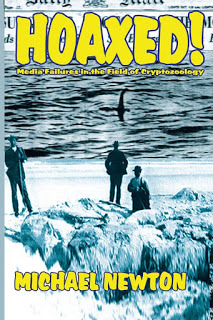 Hoaxed!
by Michael Newton (© Michael Newton/CFZ Press)
Hoaxed!
by Michael Newton (© Michael Newton/CFZ Press)
Finally: several other cryptozoological researchers, including Paul Bestall, Loren Coleman, Richard Freeman, Scott Mardis, and Carl Marshall, have independently voiced similar doubts online and elsewhere to my own concerning the Wetherell/Spurling toy submarine-featuring hoax claim, and Michael Newton has devoted an informative chapter highlighting its perceived failings in his excellent book Hoaxed! (2014), which once again I highly recommend. So it's good to know that I'm not a lone voice crying out in the wilderness!
I wish to thank very sincerely my fellow cryptozoologist and longstanding friend Carl Marshall for inspiring and encouraging me to prepare this extensive ShukerNature article, one that I had long promised myself I would write but somehow had never got around to doing. I hope that you enjoy it, Carl, and I wish to place on record here that I feel very happy and optimistic for the future of cryptozoology, knowing that it rests in such sound, steady hands and such a knowledgeable, scientifically-disciplined mind as yours and those of others like you.
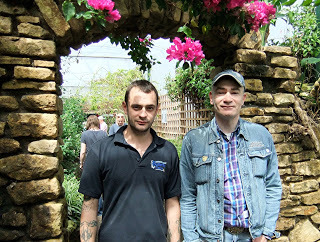 Carl meets Karl – Carl Marshall and I during a very enjoyable get-together on 2 June 2013 at the Stratford Butterfly Farm in Stratford-upon-Avon, Warwickshire, England (© Dr Karl Shuker)
Carl meets Karl – Carl Marshall and I during a very enjoyable get-together on 2 June 2013 at the Stratford Butterfly Farm in Stratford-upon-Avon, Warwickshire, England (© Dr Karl Shuker)
March 12, 2021
'PAN' - A SHUKERNATURE BOOK REVIEW
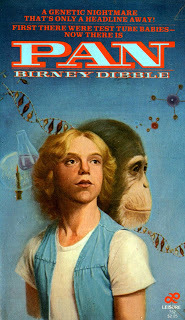 This is the paperback First Edition (not sure if there was ever a hardback First Edition) of Pan (© Birney Dibble/Leisure Books, of Nordon Publications: New York, 1980 – reproduced here on a strictly non-commercial Fair Use basis for educational/review purposes only)
This is the paperback First Edition (not sure if there was ever a hardback First Edition) of Pan (© Birney Dibble/Leisure Books, of Nordon Publications: New York, 1980 – reproduced here on a strictly non-commercial Fair Use basis for educational/review purposes only)
Over the years there have been many claims that scientific attempts have been made to create human-ape hybrids, especially so-called humanzees (human x chimpanzee hybrids), but no such forms have ever been confirmed (as I document fully here, even the enigmatic bipedal entity Oliver was conclusively revealed to be a pure-bred chimpanzee). I purchased and first read this unusual science fiction novel exploring the humanzee theme back in the early 1980s as a university student, but today no-one I've spoken to seems even to have heard of it, so here is a short ShukerNature review of Pan.
Written by American surgeon and novelist Birney Dibble and first published in 1980, Pantells the harrowing and ultimately tragic story of the world's first chimpanzee-human hybrid, created by a wholly unscrupulous rebel scientist, John Reynolds. Assisted by his weak, acquiescent wife, Sylvia, Reynolds stops at nothing, including kidnap, imprisonment, and murder, to achieve his obsessive, Frankensteinian objective.
His goal? By raising this unique entity, whom he names Pan, as if he were his son, Reynolds hopes to divine and thence unlock the hitherto arcane secrets of what truly makes a human human, and ultimately to be the first scientist to discover, by conversing in depth with Pan once mature, how the fusion of human and ape manifests within his mental and physical development.
The reality? Something very different, much darker, and so devastatingly disappointing to Reynolds that his entire world is destroyed, and Pan's transformed out of all recognition, on that fateful day when Reynolds and Sylvia finally reveal to Pan who – and what – he really is. The official blurb for Pan is as follows:
Science created him, mankind rejected him!
He was the first of a totally new species, the result of a unique scientific experiment. Half-man, half-beast, he inhabited a world of shadows, torn between his human and animal natures. The conflict within him threatened not only the success of the experiment, but Pan's own life, and the life of the one person who cared about him!
In this novel, Pan is named after the demi-god Pan from classical Greek mythology, the mercurial deity of Nature who was himself half-human, half-beast, and he becomes just as skilful musically as was his legendary namesake, after whom panpipes are named.
Interestingly, Pan is one of three different novels dealing with artificially-created ape-human hybrids that were all published within a relatively space of time, but each took this basic theme along a very different pathway from the other two.
One of these other two was Chimera by English screenwriter/novelist Steven Gallagher, published in 1982, which I've read and enjoyed. It was subsequently converted into an equally thrilling, and chilling, British TV mini-series of the same title (but retitled Monkey Boy for the American market), produced by Anglia TV for ITV and first screened in 1991, which I have lately purchased on DVD. In this two-part show, the laboratory-created hybrid, named Chad, has been produced by genetic engineering at a top-secret governmental establishment, but his behaviour becomes increasingly unstable as he grows older, and he finally escapes, to wreak mayhem and murder in the outside world as his creators frantically seek to recapture him.
Sometimes confused with Chimera by present-day TV enthusiasts is another, slightly earlier but less famous British TV mini-series, this time produced by the BBC, originally screened in 1988, and entitled First Born. Consisting of three episodes, it stars Charles Dance as the rebel scientist figure, a genetic researcher named Edward Forester, who produces a male human-gorilla hybrid. However, his attempts to surreptitiously rear his creation, whom he names Gor, have horrifying unforeseen consequences. Again, I have this series on DVD, but unlike Chimera I have not as yet read the novel that inspired it – Gor Saga, written by English novelist/playwright/poet Maureen Duffy, published in 1981, and adapted for the TV mini-series by Ted Whitehead.
 The official DVDs of Chimera and First Born (
©
Stephen Gallagher/Lawrence Gordon Clark/Zenith Entertainment/Anglia Television/Revelation Films Ltd &
© Maureen Duffy/Ted Whitehead/Philip Saville/BBC/2entertain Ltd – reproduced here on a strictly non-commercial Fair Use basis for educational/review purposes only)
The official DVDs of Chimera and First Born (
©
Stephen Gallagher/Lawrence Gordon Clark/Zenith Entertainment/Anglia Television/Revelation Films Ltd &
© Maureen Duffy/Ted Whitehead/Philip Saville/BBC/2entertain Ltd – reproduced here on a strictly non-commercial Fair Use basis for educational/review purposes only)
PAN - A SHUKERNATURE BOOK REVIEW
 This is the paperback First Edition (not sure if there was ever a hardback First Edition) of Pan (© Birney Dibble/Leisure Books, of Nordon Publications: New York, 1980 – reproduced here on a strictly non-commercial Fair Use basis for educational/review purposes only)
This is the paperback First Edition (not sure if there was ever a hardback First Edition) of Pan (© Birney Dibble/Leisure Books, of Nordon Publications: New York, 1980 – reproduced here on a strictly non-commercial Fair Use basis for educational/review purposes only)
Over the years there have been many claims that scientific attempts have been made to create human-ape hybrids, especially so-called humanzees (human x chimpanzee hybrids), but no such forms have ever been confirmed (as I document fully here, even the enigmatic bipedal entity Oliver was conclusively revealed to be a pure-bred chimpanzee). I purchased and first read this unusual science fiction novel exploring the humanzee theme back in the early 1980s as a university student, but today no-one I've spoken to seems even to have heard of it, so here is a short ShukerNature review of Pan.
Written by American surgeon and novelist Birney Dibble and first published in 1980, Pantells the harrowing and ultimately tragic story of the world's first chimpanzee-human hybrid, created by a wholly unscrupulous rebel scientist, John Reynolds. Assisted by his weak, acquiescent wife, Sylvia, Reynolds stops at nothing, including kidnap, imprisonment, and murder, to achieve his obsessive, Frankensteinian objective.
His goal? By raising this unique entity, whom he names Pan, as if he were his son, Reynolds hopes to divine and thence unlock the hitherto arcane secrets of what truly makes a human human, and ultimately to be the first scientist to discover, by conversing in depth with Pan once mature, how the fusion of human and ape manifests within his mental and physical development.
The reality? Something very different, much darker, and so devastatingly disappointing to Reynolds that his entire world is destroyed, and Pan's transformed out of all recognition, on that fateful day when Reynolds and Sylvia finally reveal to Pan who – and what – he really is. The official blurb for Pan is as follows:
Science created him, mankind rejected him!
He was the first of a totally new species, the result of a unique scientific experiment. Half-man, half-beast, he inhabited a world of shadows, torn between his human and animal natures. The conflict within him threatened not only the success of the experiment, but Pan's own life, and the life of the one person who cared about him!
In this novel, Pan is named after the demi-god Pan from classical Greek mythology, the mercurial deity of Nature who was himself half-human, half-beast, and he becomes just as skilful musically as was his legendary namesake, after whom panpipes are named.
Interestingly, Pan is one of three different novels dealing with artificially-created ape-human hybrids that were all published within a relatively space of time, but each took this basic theme along a very different pathway from the other two.
One of these other two was Chimera by English screenwriter/novelist Steven Gallagher, published in 1982, which I've read and enjoyed. It was subsequently converted into an equally thrilling, and chilling, British TV mini-series of the same title (but retitled Monkey Boy for the American market), produced by Anglia TV for ITV and first screened in 1991, which I have lately purchased on DVD. In this two-part show, the laboratory-created hybrid, named Chad, has been produced by genetic engineering at a top-secret governmental establishment, but his behaviour becomes increasingly unstable as he grows older, and he finally escapes, to wreak mayhem and murder in the outside world as his creators frantically seek to recapture him.
Sometimes confused with Chimera by present-day TV enthusiasts is another, slightly earlier but less famous British TV mini-series, this time produced by the BBC, originally screened in 1988, and entitled First Born. Consisting of three episodes, it stars Charles Dance as the rebel scientist figure, a genetic researcher named Edward Forester, who produces a male human-gorilla hybrid. However, his attempts to surreptitiously rear his creation, whom he names Gor, have horrifying unforeseen consequences. Again, I have this series on DVD, but unlike Chimera I have not as yet read the novel that inspired it – Gor Saga, written by English novelist/playwright/poet Maureen Duffy, published in 1981, and adapted for the TV mini-series by Ted Whitehead.
 The official DVDs of Chimera and First Born (
©
Stephen Gallagher/Lawrence Gordon Clark/Zenith Entertainment/Anglia Television/Revelation Films Ltd &
© Maureen Duffy/Ted Whitehead/Philip Saville/BBC/2entertain Ltd – reproduced here on a strictly non-commercial Fair Use basis for educational/review purposes only)
The official DVDs of Chimera and First Born (
©
Stephen Gallagher/Lawrence Gordon Clark/Zenith Entertainment/Anglia Television/Revelation Films Ltd &
© Maureen Duffy/Ted Whitehead/Philip Saville/BBC/2entertain Ltd – reproduced here on a strictly non-commercial Fair Use basis for educational/review purposes only)
March 7, 2021
A MYSTERY GHARIAL FROM AUSTRALIA?
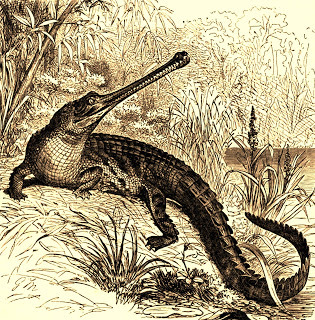 Exquisite 19th-Century engraving of the gharial (public domain)
Exquisite 19th-Century engraving of the gharial (public domain) The most distinctive, readily identifiable species of crocodilian alive today is the gharial or gavial Gavialis gangeticus, due to its exceedingly long, slender jaws and its very sizeable total length (a few specimens exceeding 20 ft have been confirmed; only the estuarine crocodile is longer). However, the gharial is confined entirely to the Indian subcontinent. Nothing like it has ever been recorded from modern-day Australia – officially...
The huge estuarine or saltwater crocodile (up to 20 ft long, sometimes slightly more), and the smaller freshwater or Johnston's crocodile Crocodylus johnstoni are the only two species of crocodile known to exist in Australia today. However, Australian herpetologist Richard Wells has informed me that when he lived in the Northern Territory during the early 2000s, he received a number of consistent reports from a variety of independent informants, including aboriginals, old ex-crocodile hunters, and fish poachers, suggesting that the tidal parts of its Mary River system was home to a third, very large but dramatically different crocodilian that is apparently unidentified by science.
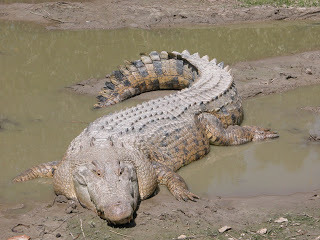 Estuarine (saltwater) crocodile (public domain)
Estuarine (saltwater) crocodile (public domain)
According to Wells's data, kindly shared by him with me:
[it] would appear to be totally aquatic with an elongated jaw with numerous exposed teeth more in keeping with that of some kind of gharial (Gavialis) – but it appears to reach a larger size, has paddle-like limbs, and is of nocturnal behaviour. Most reports of the creature have been dismissed as representing sawfish or crocodiles, but all the people who reported it were very familiar with sawfish and crocs, but were adamant that it is some sort of crocodile-like reptile and it scared the hell [out] of them.
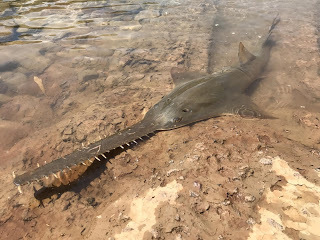 Largetooth sawfish Pristis pristis in Daly River, Northern Territory, Australia (© Peter Kyne/Wikipedia –
CC BY 3.0 licence
)
Largetooth sawfish Pristis pristis in Daly River, Northern Territory, Australia (© Peter Kyne/Wikipedia –
CC BY 3.0 licence
)
So what could this gharial lookalike be? Interestingly, crocodiles in zoos that have been fed a low-protein diet sometimes develop exposed teeth that jut out laterally from the jaws. So could the Mary River mystery crocodile simply constitute size-exaggerated freak specimens of one or other of Australia's two known species?
Worth noting is that Johnston's crocodile does possess a rather long, superficially gharial-like snout. But this does not explain the paddle-like limbs cited for the Mary River beast (thus rendering the already-improbable possibility of an undiscovered population of bona fide gharials existing here even more improbable).
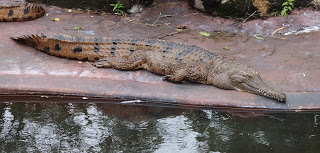 Johnston's crocodile (© Mark Marathon/Wikipedia –
CC BY-SA 4.0 licence
)
Johnston's crocodile (© Mark Marathon/Wikipedia –
CC BY-SA 4.0 licence
)
Intrigued by this cryptid, I contacted Australian reptile palaeontologist Dr Ralph Molnar for his views, and he aired a thought that had occurred to me too. Namely, that a paddle-limbed crocodilian instantly recalls the thalattosuchians or sea crocodiles.
Thalattosuchians constituted a prehistoric group of highly-specialised, elongate-bodied, and wholly-aquatic marine reptiles related to true crocodilians and superficially similar to them too. As they lacked the osteoderms of true crocodilians, however, they were smooth-skinned. In addition, they possessed flippers as limbs instead of claw-footed legs, and probably bore a distinctive tail fin. Yet despite being well-adapted for their maritime lifestyle, they were a relatively short-lived group, and vanished from the known fossil record over 120 million years ago.
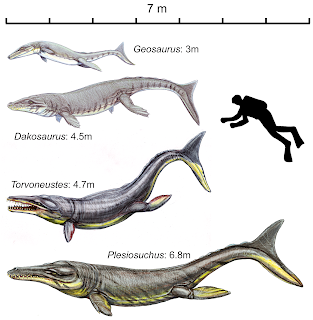 Reconstructions of the possible appearance in life of various thalattosuchians (© Mark T Young et al/Wikipedia –
CC BY 2.5 licence
)
Reconstructions of the possible appearance in life of various thalattosuchians (© Mark T Young et al/Wikipedia –
CC BY 2.5 licence
)
But could it be that a lineage of thalattosuchians has somehow survived into the present day, undetected by science and only subtly changed from those ancient times? It seems highly unlikely, and yet it would not be the first time that the existence of a 'living fossil' (or Lazarus taxon) has been confirmed.
A much more conservative, alternative option, but still involving prehistoric survival, hinges upon whether the eyewitnesses' claims that the Mary River crocodile's feet are paddled are strictly accurate. Could they simply be more rounded than those of Australia's pair of known crocodile species? For if they are not truly paddled, a very remarkable identity for the Mary River crocodile, as noted by Dr Molnar, becomes available for consideration.
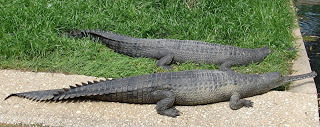 A pair of captive gharials (public domain)
A pair of captive gharials (public domain)
Less than two million years ago, a very gharial-like Pleistocene species known as the Murua crocodile, and variously dubbed Gavialis or Ikanogavialispapuensis, inhabited Murua (aka Muyua and Woodlark Island) and the Solomon Sea surrounding it, just above southeastern New Guinea, and therefore in close proximity to the waters off Australia's Northern Territory. In the past, some authorities were more in favour of classifying this 7-10-ft-long species as a thoracosaur (prehistoric reptiles that may or may not have even been crocodilian in identity). Yet whereas initially sceptical, Molnar subsequently informed me that it might well have been a species of gharial (although he believed that it was distinct from the genus Gavialis). Certainly, its elongated snout was very like the latter's, as was its piscivorous diet, and nowadays it is indeed housed within the gharial's taxonomic family (but delineated by some workers within the genus Ikanogavialis rather thanGavialis). Moreover, it appeared to have been a fully marine gharial, thereby making it the most geologically-recent marine crocodilian currently known to science. In 1982, Molnar documented this intriguing species within a Memoirs of the Queensland Museum paper.
Based upon what is known of its morphology from fossil evidence, the Murua crocodile would correspond very closely indeed with the Mary River's mystery reptile, though it was smaller than the latter cryptid is said to be (but as noted earlier here, this greater size may simply be a product of exaggeration or poor estimation on the part of eyewitnesses). Some reptilian authorities have suggested that the Murua crocodile may have survived beyond the Pleistocene, perhaps until as recently as the late Holocene, but in view of Wells's reports it may actually still exist today. If there really is a marine gharial species awaiting scientific discovery in the tidal portion of Australia's Mary River system, let us hope that a day will come when the remains of one of the latter's mystery crocodiles will be found and its taxonomic identity finally revealed.
This ShukerNature blog article is extracted and updated from my books Mirabilis: A Carnival of Cryptozoology and Unnatural History and Still In Search Of Prehistoric Survivors: The Creatures That Time Forgot?.
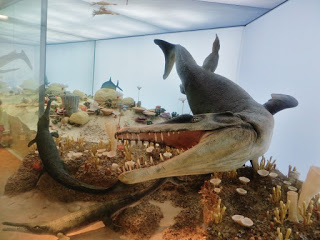 Thalattosuchian models, Geosaurus(left, small) and Dakosaurus (right, big), at the Museum am Löwentor, in Stuttgart, Germany (© Ghedoghedo/Wikipedia –
CC BY-SA 4.0 licence
)
Thalattosuchian models, Geosaurus(left, small) and Dakosaurus (right, big), at the Museum am Löwentor, in Stuttgart, Germany (© Ghedoghedo/Wikipedia –
CC BY-SA 4.0 licence
)
February 19, 2021
MEET THE MBIELU-MBIELU-MBIELU - SO GOOD, THEY NAMED IT THRICE!
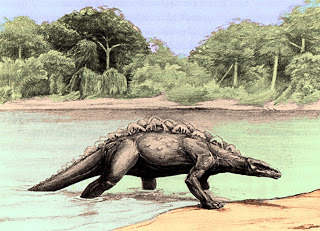 Representation of the mbielu-mbielu-mbielu, based upon eyewitness descriptions (© Drawn by David Miller under the direction of Prof. Roy P. Mackal)
Representation of the mbielu-mbielu-mbielu, based upon eyewitness descriptions (© Drawn by David Miller under the direction of Prof. Roy P. Mackal) In addition to the very famous sauropod-lookalike mokele-mbembe and the somewhat less famous nose-horned emela-ntouka (but click herefor an extensive ShukerNature article concerning it), a third sizeable cryptid has also been reported from the Republic of the Congo's vast, scarcely penetrable Likouala swamplands. Namely, the mbielu-mbielu-mbielu – so good, they named it thrice! During his two expeditions to this region during the early 1980s, veteran cryptozoologist Prof. Roy P. Mackal collected some interesting anecdotal evidence concerning this hitherto-obscure Congolese mystery beast, and also regarding a fourth, possibly related one, which he duly documented in his classic cryptozoology book A Living Dinosaur?(1987) and which are eminently deserving of being recalled here on ShukerNature.
According to one of the mbielu-mbielu-mbielu's alleged eyewitnesses – a young woman called Odette Gesonget, from the village of Bounila – this triple-termed cryptid is a semi-aquatic beast "with planks growing out of its back". In a bid to identify it, Mackal showed Gesonget several illustrated books depicting animals from the present and also from the distant past – and the picture that she unhesitatingly selected was of the prehistoric plate-bearing non-avian dinosaur Stegosaurus. Comparable descriptions were offered independently by native eyewitnesses s encountered elsewhere during Mackal's Congolese travels too.
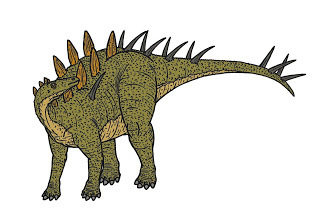 Life restoration of Kentrosaurus(public domain)
Life restoration of Kentrosaurus(public domain)
Yet although at least one stegosaur genus, Kentrosaurus, is indeed represented by fossil remains found in tropical Africa, there is no suggestion from fossil evidence that stegosaurs exhibited any amphibious inclination. But who can say whether, during the intervening 65 or more million years from the most recent known fossils to the present day, an evolved surviving stegosaur might have become secondarily aquatic?
It is possible that this beast, whatever its taxonomic identity may be, is related to (or is even one and the same as) yet another mystery animal from the Likouala swamplands – the nguma-monene, which has been reported from the Mataba tributary of the Ubangi River. According to native descriptions, it resembles a colossal snake (at least 130 ft long!), but bears a serrated dorsal ridge along most of its body's length consisting of numerous triangular protrusions, possesses four short legs, and can walk upon land, with a low-slung body and forked tongue. Suggestions that have been offered for the nguma-monene's taxonomic identity include a snake-like non-avian dinosaur, a very elongate varanid (monitor lizard), and even a primitive reptile descended from the ancestral forms that gave rise to lizards and snakes.
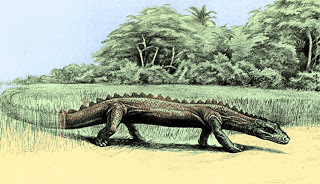 Representation of the nguma-monene, based upon eyewitness descriptions (© Drawn by David Miller under the direction of Prof. Roy P. Mackal)
Representation of the nguma-monene, based upon eyewitness descriptions (© Drawn by David Miller under the direction of Prof. Roy P. Mackal)
A remarkable modern-day sighting of the nguma-monene by a Westerner was recorded by fellow Congolese cryptid seeker William J. Gibbons in his own book Mokele-Mbembe: Mystery Beast of the Congo(2010), which also documents the various other Congolese and Cameroon cryptids sought by him during his expeditions. The eyewitness in question was Pastor Joseph Ellis, who informed Gibbons personally of his encounter.
It took place one clear sunny day in November 1971, when Ellis was journeying north in his 30-ft-long motorised canoe on the Motaba River. Suddenly he spied a huge, elongated, snake-like creature with a series of ridges like the edge of a saw running the length of its back. It was moving just across the river from the right bank, only around 100 ft away. Turning off his canoe's engine, an astonished Ellis watched as the creature, which he could see was at least as long as his canoe, swam slowly across the river to its left bank, onto which it clambered, crawling through the thick grass and then disappearing into the jungle.
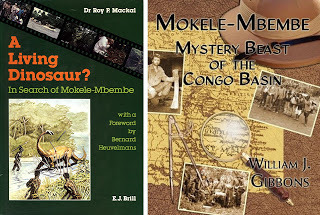 Roy Mackal's book and William Gibbons's book (© Roy P. Mackal/E.J. Brill & William Gibbons/Coachwhip Publications)
Roy Mackal's book and William Gibbons's book (© Roy P. Mackal/E.J. Brill & William Gibbons/Coachwhip Publications)
Ellis never saw its head, but just the section of its body that was visible to him was at least 30 ft long, and was greyish-brown in colour. Although he had personally seen many of this region's large species of animal currently documented by science (including elephants, monitors, pythons, turtles, and crocodiles), he had never spied anything like this creature before, and, having no interest in cryptozoology, had not previously known of its existence here. What could it have been?
Mackal favoured a single, very large, and radically new species of monitor lizard as the most satisfactory explanation for both the nguma-moneme and the mbielu-mbielu-mbielu. Nonetheless, the latter's stegosaurian parallels are evidently difficult to dismiss absolutely – because as he confessed in his book: "For me, mbielu-mbielu-mbielu remains an enigma".
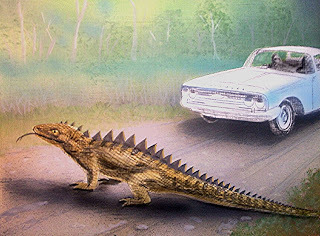 Artistic representation of the Bombays' encounter with a muhuru (© William M. Rebsamen)
Artistic representation of the Bombays' encounter with a muhuru (© William M. Rebsamen)
Nor are the two Congolese examples documented above the only dorsally-distinctive crypto-reptiles on record from Africa. One day in summer 1961, missionary Cal Bombay and his wife were driving through the Rift Valley on their way to Nairobi, Kenya, when they had to pull up sharply in order to avoid hitting an extremely large reptile apparently sunning itself in the middle of the road. The Bombays estimated that the creature, which was dark grey in colour, measured around 10 ft long, had a snake-like head, four stubby legs, and, most remarkable of all, bore a series of diamond-shaped serrations running down its entire mid-dorsal line, from the back of its head to the tip of its tail.
After about 20 minutes, thus giving its observers plenty of time to peruse it closely, this languorous mystery beast finally stood up, and sauntered lazily into the bush. When some Kenyan natives heard of their encounter, they referred to the creature as a muhuru, but nothing like it is known to Western zoologists.
This ShukerNature article is excerpted and adapted from my book Still In Search Of Prehistoric Survivors.
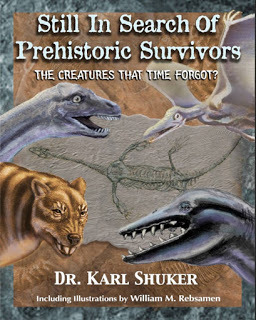
February 18, 2021
THE GIANT STONE TORTOISES OF KARAKORUM – A MONUMENTAL MYSTERY FROM MONGOLIA
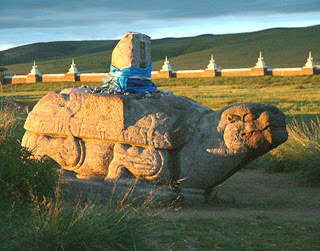 Giant stone tortoise at Karakorum, Mongolia (© Frithjof Spangenberg/Wikipedia –
CC BY-SA 2.5 licence
)
Giant stone tortoise at Karakorum, Mongolia (© Frithjof Spangenberg/Wikipedia –
CC BY-SA 2.5 licence
)
In the Russian republic of Buryatia (in southcentral Siberia), the Russian Far East, the Korean Peninsula, and, particularly, Mongolia, a number of very large stone statues of tortoises can be found – but these are no ordinary tortoises, as documented by chelonian expert and palaeobiologist Prof. Viacheslav Mikhailovich Chkhikvadze, from the Georgian Academy of Sciences in Tbilisi.
In a Prirodaarticle from 1988, Prof. Chkhikvadze focused much of his attention upon three such statues in Mongolia, still standing amid the palace ruins at Karakorum, which was once the Mongol Empire's capital city. The biggest of these statues dates back to the 13th Century, and measures 92 ft long, 34.5 ft wide, and 41 ft high. The Mongolian name for it sounds like 'jastmel'chij'.
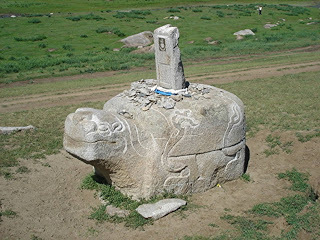 A second giant stone tortoise at Karakorum, Mongolia (© Methos31/Wikipedia –
CC BY-SA 3.0 licence
)
A second giant stone tortoise at Karakorum, Mongolia (© Methos31/Wikipedia –
CC BY-SA 3.0 licence
)
They all portray a type of huge long-shelled tortoise with a giant head on a thick neck, protruding eyes, and – incongruously for a tortoise - a pair of short, closely-pressed ears. Equally odd are the sharp teeth that project from the upper jaw (chelonians are normally toothless), and all four feet have five long claws. One of the statues incorporates an inset seat for visitors to sit upon.
A particularly old example of these statues, dating from the 8th Century, was found in Mongolia's northern province, and has subsequently become the subject of much study at the archaeological department of the Academic History Institute in Ulan Bator. Moreover, there were further examples at each gate on the four sides of the city wall at Karakorum. Steles (pillars) were present on the backs of these tortoises, which were crowned with beacons for travellers in the steppe.
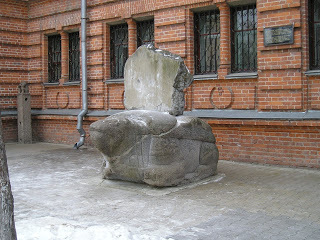 The giant stone tortoise originally on the grave mound of Asikui, now at Khabarovsk Museum (© Glucke/Wikipedia –
CC BY-SA 3.0 licence
)
The giant stone tortoise originally on the grave mound of Asikui, now at Khabarovsk Museum (© Glucke/Wikipedia –
CC BY-SA 3.0 licence
)
Perhaps the most famous of the giant stone tortoise monuments outside Mongolia is the example discovered by early Russian settlers in 1868, on the grave mound of the Jurchen general Asikui, where it had been installed in c.1193. Originally sited near the village of Nikolskoye (today the city of Ussuriysk) in what is now the Russian Far East, in 1895 it was transported to the I.N. Grodekov Khabarovsk Territorial Museum of Regional Studies. It dates from the Jin Dynasty (1115-1234).
What made them so intriguing to Prof. Chkhikvadze is that in his view, their basic tortoise form that is revealed once its stylised non-chelonian features – ears, teeth – are stripped away bears a remarkable similarity to the American snapping turtle Chelydra serpentina. In prehistoric times, its taxonomic family, Chelydridae, was distributed widely in Europe, Asia, and the New World, but today it is confined exclusively to the Americas (except of course for snapping turtle escapees/releases from captivity, several of which have been found living in British and other European ponds and lakes during recent years – click hereto read about some sizeable, highly-publicised examples that were found some years ago very near to my home in the West Midlands, England).
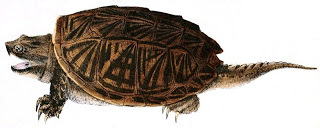 American snapping turtle, 1842 engraving
from John Edwards Holbrook's book North American Herpetology
(public domain)
American snapping turtle, 1842 engraving
from John Edwards Holbrook's book North American Herpetology
(public domain)
Consequently, as noted by Chkhikvadze, it remains a riddle how Central Asiatic sculptors in the Middle Ages knew a type of tortoise that in the Old World had been considered extinct for the past two million years. There is a remote possibility that these sculptors had seen fossilised remains of prehistoric Asian chelydrids. Unusual or eyecatching fossils have inspired a number of medieval representations in a wide range of localities globally, so such a situation would hardly be unique. Also remote, but again not impossible, is that a species of large Asian chelydrid survived into much more recent times than is currently known from the fossil record, and either directly or via generations of verbally-transmitted descriptions inspired the sculptors responsible for the statues.
Incidentally, such explanations as these may also account for another anomalous portrayal, but this time at Marcahausi, which is a plateau 13,000 ft above sea level, and situated some 50 miles northeast of Lima, in Peru. It was here that in 1952 Dr Daniel Ruzo discovered a series of fascinating megalithic sculptures. Not only did they include some enormous human figures carved from the rocks but also a wide range of animals, including lions, camels, elephants – and one that in Ruzo's opinion seemed to represent an amphichelydian – i.e. belonging to a taxonomic group of prehistoric chelonians characterised by their non-retractable neck.
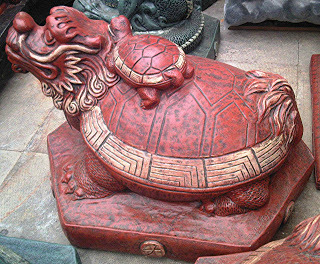 Modern-day statue of a Chinese bixi (© Dr Karl Shuker)
Modern-day statue of a Chinese bixi (© Dr Karl Shuker)
Interestingly, the carving of giant stone tortoises in the Far East underwent an evolution of its own down through the ages, witnessing as already noted the popular addition of a stele to the tortoise's back, so that it became a symbol of heavy loads and burden. And in more modern times, especially in China where dragons have always played such a significant and diverse role in this country's mythology, the giant tortoise has itself acquired the head of a dragon - yielding a ferocious-looking hybrid monster known as a bixi. (NB – this name is also applied more generally to all giant tortoise sculptures by some researchers, including those from Mongolia documented by me here.)
This ShukerNature blog article is excerpted from my book Mirabilis: A Carnival of Cryptozoology and Unnatural History.
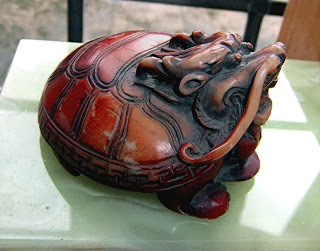 My little feng shui bixi (© Dr Karl Shuker)
My little feng shui bixi (© Dr Karl Shuker)
Karl Shuker's Blog
- Karl Shuker's profile
- 45 followers



